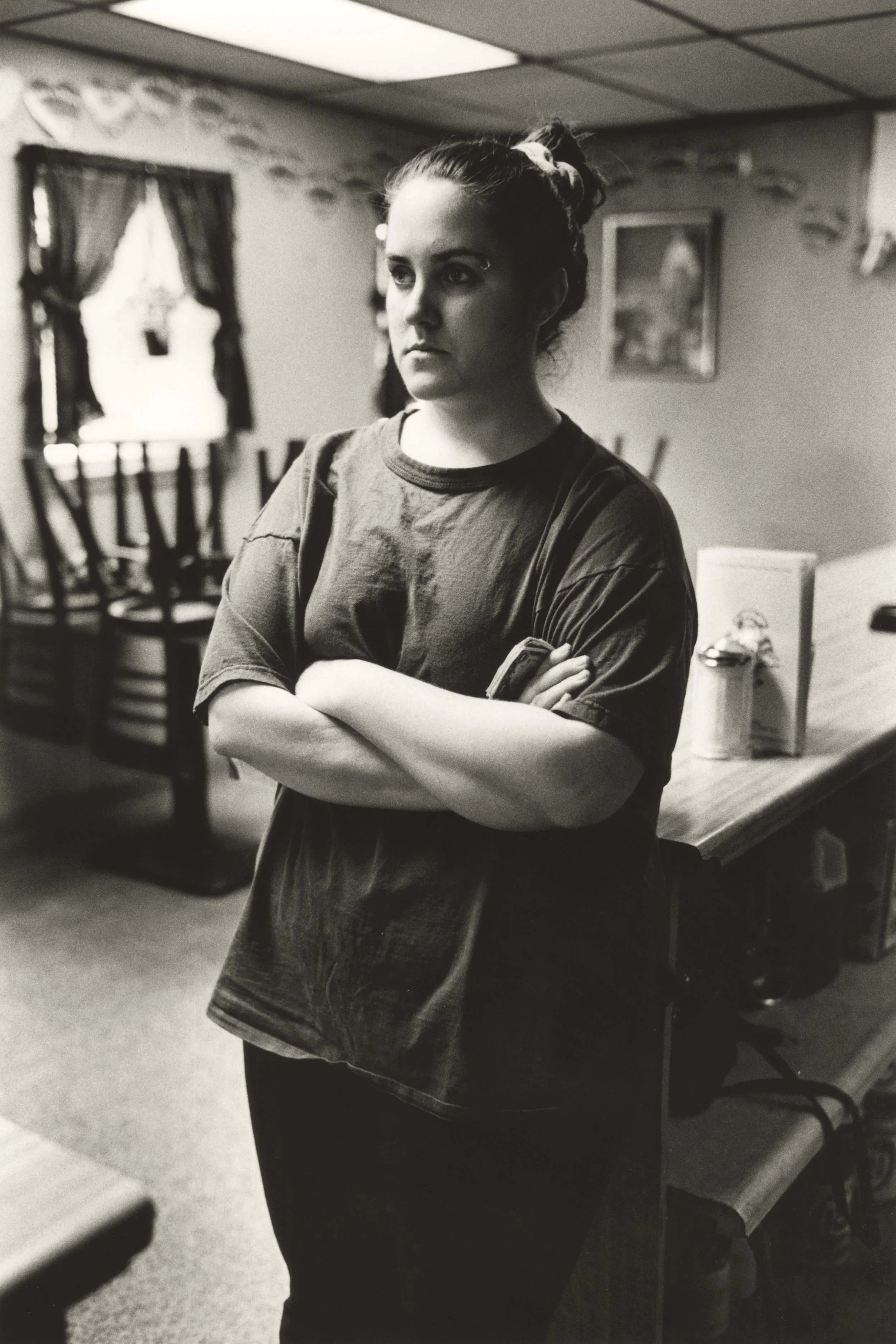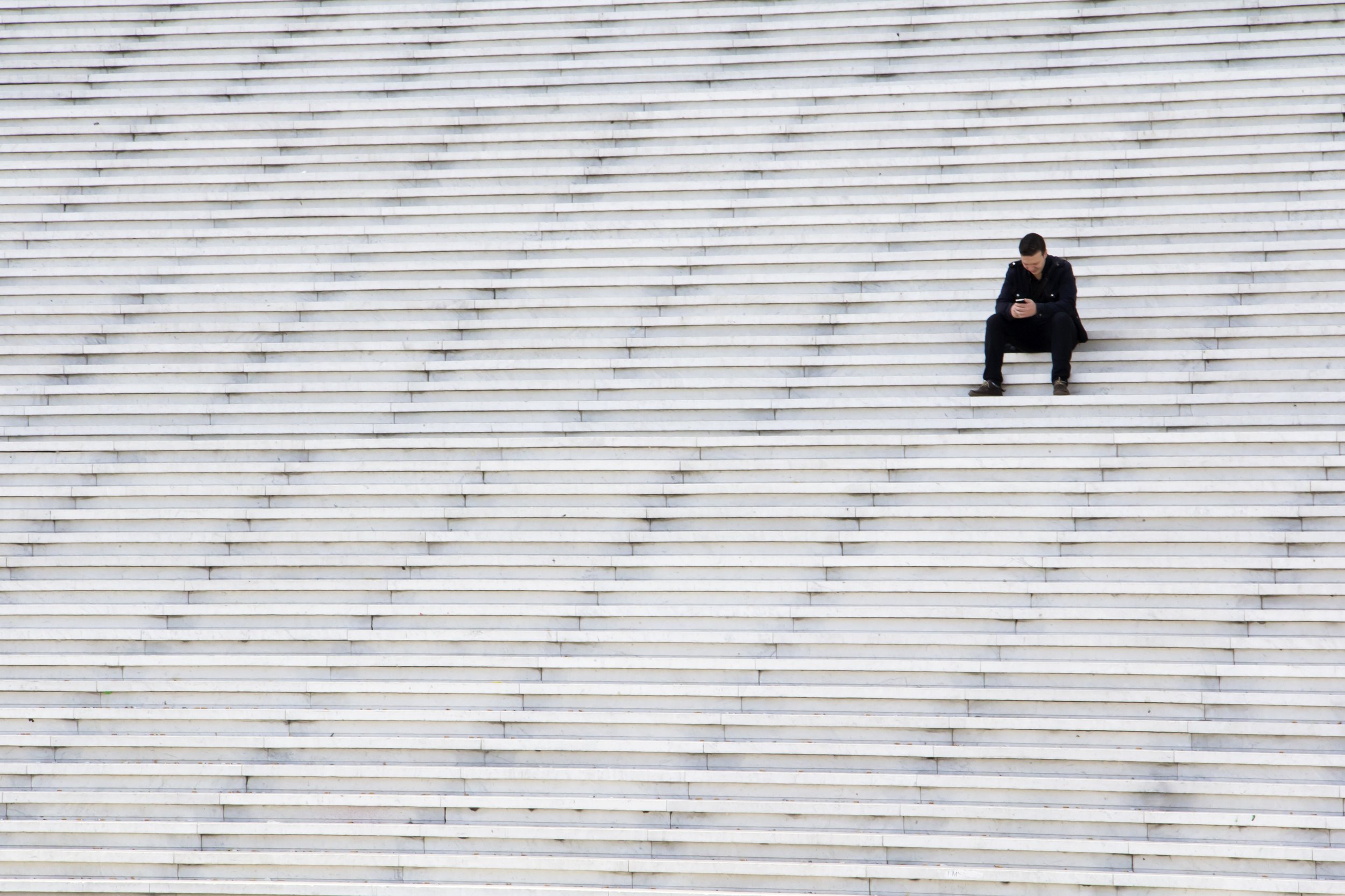



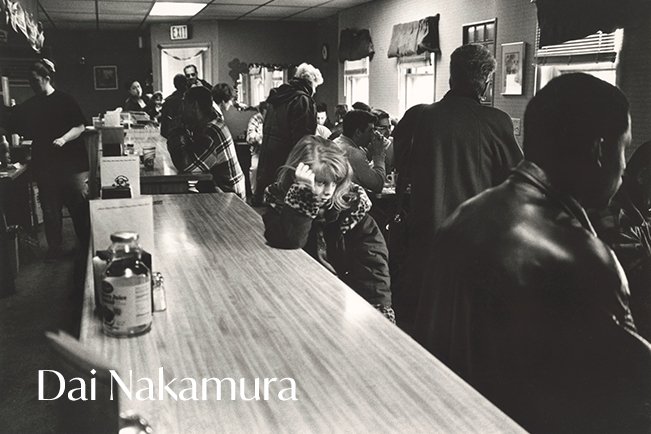





After a special extended edition of FotoNostrum Magazine dedicated exclusively to our Awards, we are thrilled to return with a fresh and vibrant selection of photographic voices from around the world. This 42nd issue brings together a diverse group of artists, many of them overall winners of our latest contests, whose work pushes the boundaries of storytelling and visual expression.
In this issue, we are proud to present the thought-provoking conceptual photography of Elisa Miller, whose bold and colorful images explore themes of identity and societal expectations. We are also captivated by the surreal and emotive world of Kseniia Antipina, who uses staged photography to delve into universal feelings of belonging and displacement, shaped by her own experience of migration.
The intimate and deeply personal work of Patricia McElroy brings us into the delicate space of memory and caregiving, as she documents life with her 94-year-old mother in her ongoing series Between Then & Now. Similarly, Sushilla Kouwen offers poetic reflections on love, loss, and resilience, using photography as a means to embrace vulnerability and beauty in life's most fragile moments.
From Japan, Dai Nakamura presents a body of work shaped by the aesthetics of wabi sabi and mono no aware, where the monochrome palette strips away the unnecessary to reveal the transient beauty of impermanence. And Diana Mehrez, working between Beirut and Barcelona, transforms her architectural vision into striking photographic compositions that blur the line between structure and abstraction, exploring the emotional depth of space and human presence within it.
We hope this issue offers a compelling and varied journey through different artistic sensibilities, each reflecting a unique perspective on life, memory, and identity.
As always, thank you for joining us in celebrating the power of photography.
Enjoy the issue!
Michal Meliško
Art Director
March 20, 2025
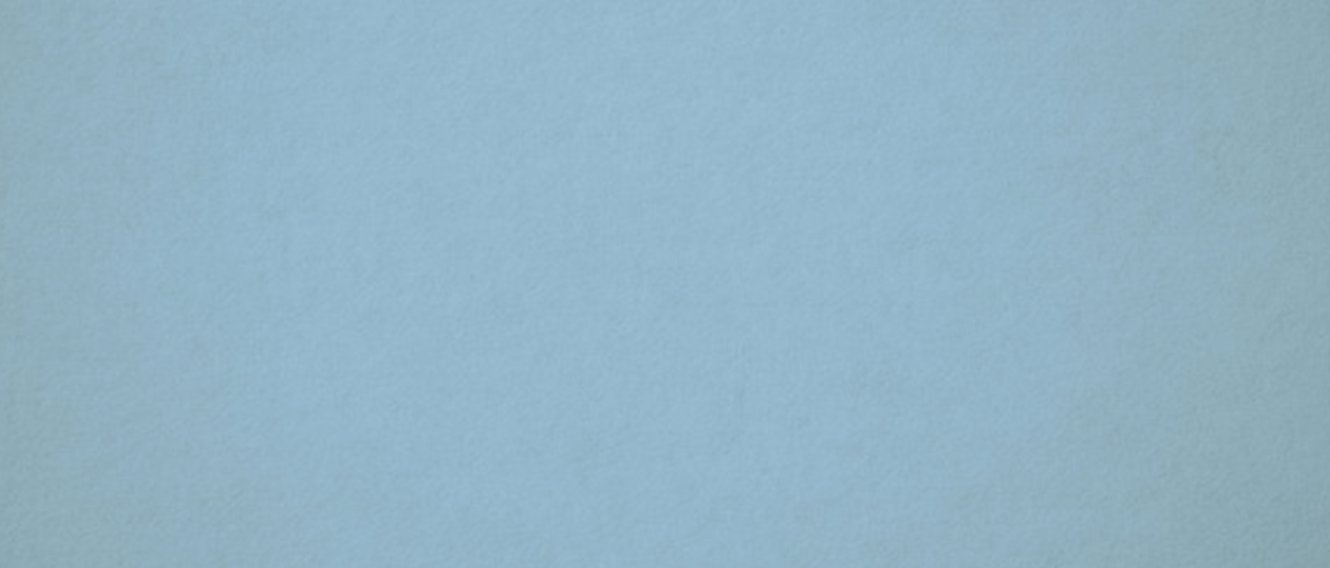
Discover
Brian Hunt
As a product of the 60s and 70s, Brian Hunt was greatly influenced by those years. His early work included pencil sketches, charcoal drawings, and watercolors. Over the past 12 years or so, photography has inspired him to continue his journey of expression, one that is formed by his life experiences. As the clock ticks on, he feels more and more compelled to leave something behind, some marker that says he was here. He hopes he can continue to build a body of work that can be that legacy.
Brian's impactful imagery has earned him acclaim in numerous photography competitions, and he maintains a global presence through his exhibitions.
Discover the artist at: www.artendipity.com/brian-hunt
Hanover Street, ©Brian Hunt
Photo-Tech News
photo_technews
A Century of Innovation: Celebrating 100 Years of the Leica I 35mm Camera
This year marks a century since the debut of the Leica I, the first commercially successful 35mm camera that transformed photography forever. Released in 1925, this compact and revolutionary device made photography more accessible, spontaneous, and portable. (Inspired by recent reflections on Leica’s centenary celebrations.)
Before the Leica I, photography relied on heavy, cumbersome equipment that limited movement and creativity. By introducing 35mm film — a format previously used for motion pictures — Leica brought unprecedented flexibility to photographers. Although many doubted whether such a small format could produce quality images, the Leica I quickly proved itself with sharp, detailed photographs that rivaled larger formats.
The driving force behind this innovation was Oskar Barnack, an engineer at Ernst Leitz Optische Werke. Originally aiming to create a lightweight camera for landscape photography, Barnack ended up reshaping the entire field. His prototype, the Ur-Leica, laid the foundation for a compact camera that allowed photographers to capture candid, fleeting moments — an essential breakthrough that paved the way for modern photojournalism.
The Leica I didn’t just introduce a new film format; it inspired a new way of seeing the world. Photographers could now move freely, documenting life as it happened. This spirit of mobility and precision remains at the heart of Leica cameras today.
As the Leica I turns 100, it stands as more than a piece of history — it’s a symbol of innovation that continues to inspire photographers to explore and capture the world around them.
Photo: © Kameraprojekt Graz 2015 / Wikimedia Commons / CC BY-SA 4.0
Video credit: © Kameraprojekt Graz 2015 / Wikimedia Commons / CC BY-SA 4.0
Patricia McElroy
United States
patriciamcelroy.com
"Your mother is your first home, and that's why we’re always trying to return to them."
— What My Mother and I Don’t Talk About, Michele Filgate
LOOKS HOT OUT THERE, from the series Between Then & Now, 2023. © Patricia McElroy
Patricia McElroy, an interdisciplinary artist, photographer, and designer, was born in Philadelphia and raised in Ireland. After earning her degree from The National College of Art & Design in Dublin, she returned to the U.S., where she established a successful design business with her husband. While her artistic practice spans multiple disciplines, photography has remained a deeply personal medium—one that allows her to explore themes of belonging, memory structures, and cultural identity, often weaving together the past and present.
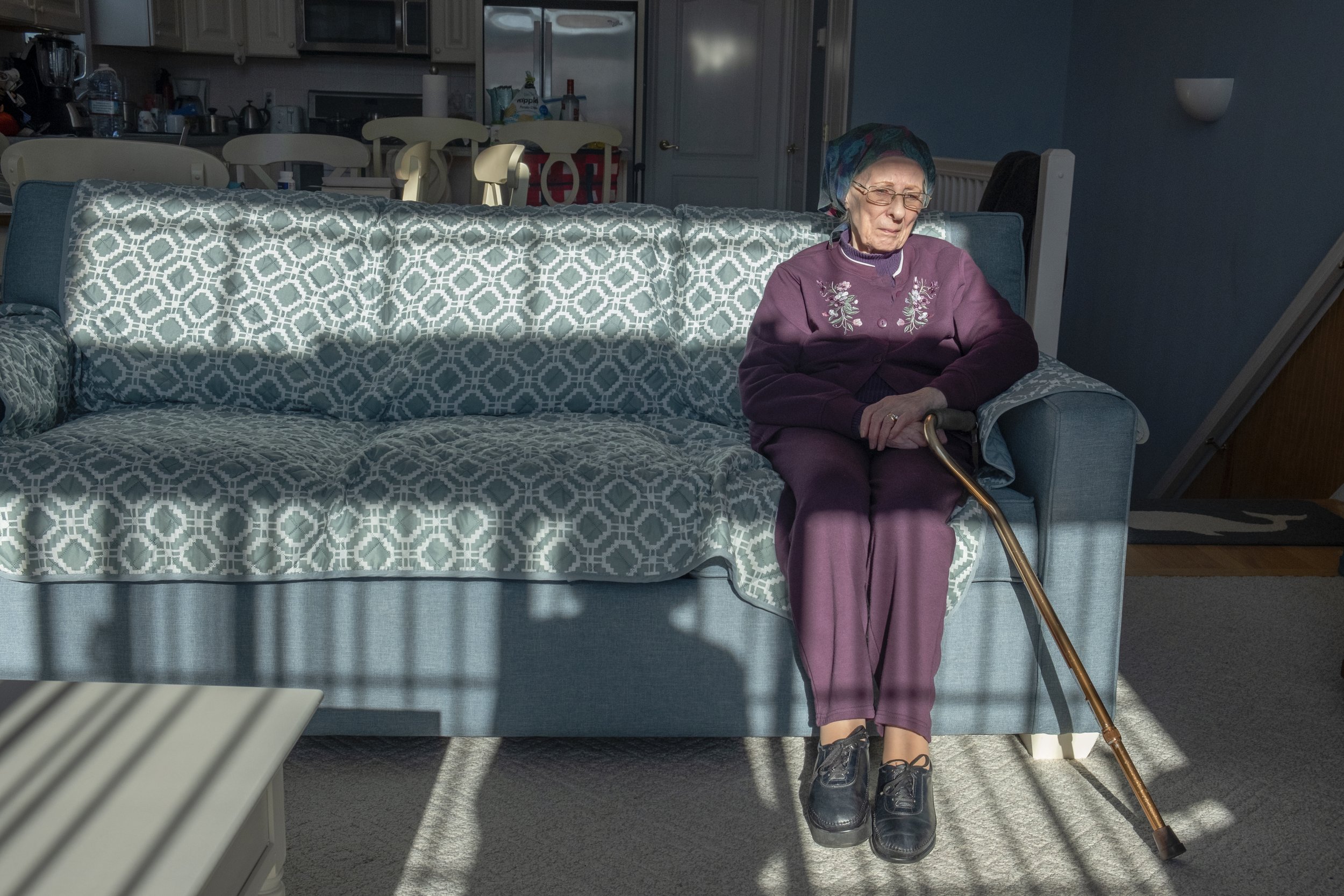
ALONE, from the series Between Then & Now, 2020. © Patricia McElroy
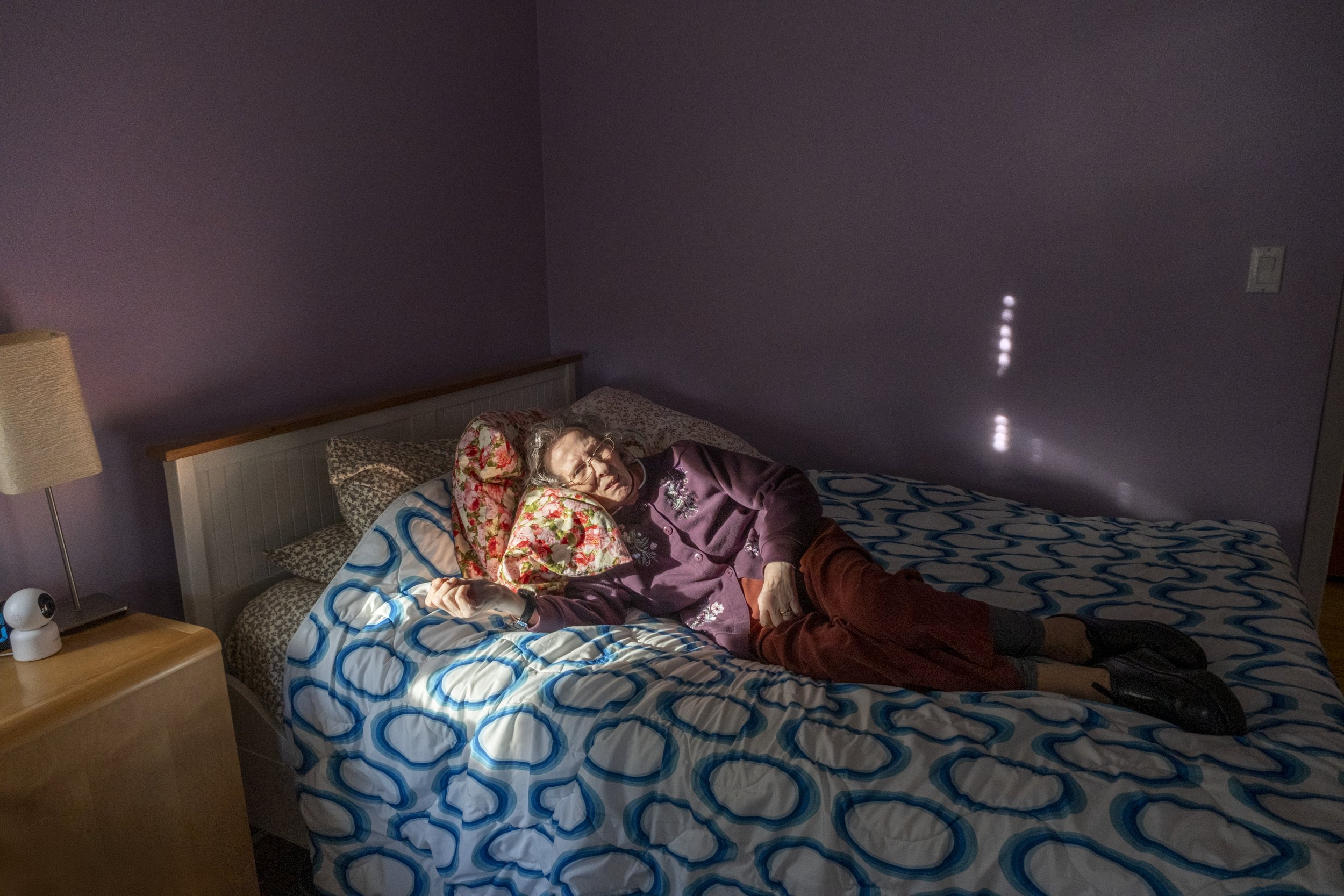
LOUNGING, from the series Between Then & Now, 2023. © Patricia McElroy

THE LOOK, from the series Between Then & Now, 2024. © Patricia McElroy
McElroy's work has been exhibited nationally and internationally, earning her numerous recognitions, including being a Critical Mass finalist in 2023 and an overall and category winner in The Pollux Awards the same year. She received an honorable mention in The Julia Margaret Cameron Awards 2023 and Photographer of the Year 2023 (All About Photo). Her series Between Then & Now has been featured in All About Photo and Lenscratch in 2024. Additionally, her work has been selected for prestigious juried exhibitions, including the Royal Hibernian Academy (2021, 2023, 2024) and the Royal Ulster Academy (2023).
HAIR DO, from the series Between Then & Now, 2024. © Patricia McElroy
THE CURL, from the series Between Then & Now, 2024. © Patricia McElroy
One of McElroy’s most poignant projects, Between Then & Now, emerged from a deeply personal experience. When her mother visited from Ireland six years ago, it became clear she could no longer live alone. At 94, despite near blindness, physical struggles, and dementia, she remains remarkably resilient. McElroy, now her caregiver, finds that time has taken on new meaning, shaping their days with fleeting recollections and moments of presence.
ROUTINE, from the series Between Then & Now, 2020. © Patricia McElroy
SERVICE FOR ONE, from the series Between Then & Now, 2022. © Patricia McElroy
PROTECTED, from the series Between Then & Now, 2020. © Patricia McElroy
Initially, photographing her mother was difficult, but over time, the process became an unexpected gift. “Dementia has stolen many of her usual sources of joy, but surprisingly, despite her past reluctance to be photographed, she now enjoys this shared experience,” McElroy reflects. Though her mother cannot see the images, her willingness to participate allows the photographer to document their relationship with honesty and sensitivity. The series explores the often-overlooked realities of aging and caregiving, capturing the fragility of memory and the weight of devotion.
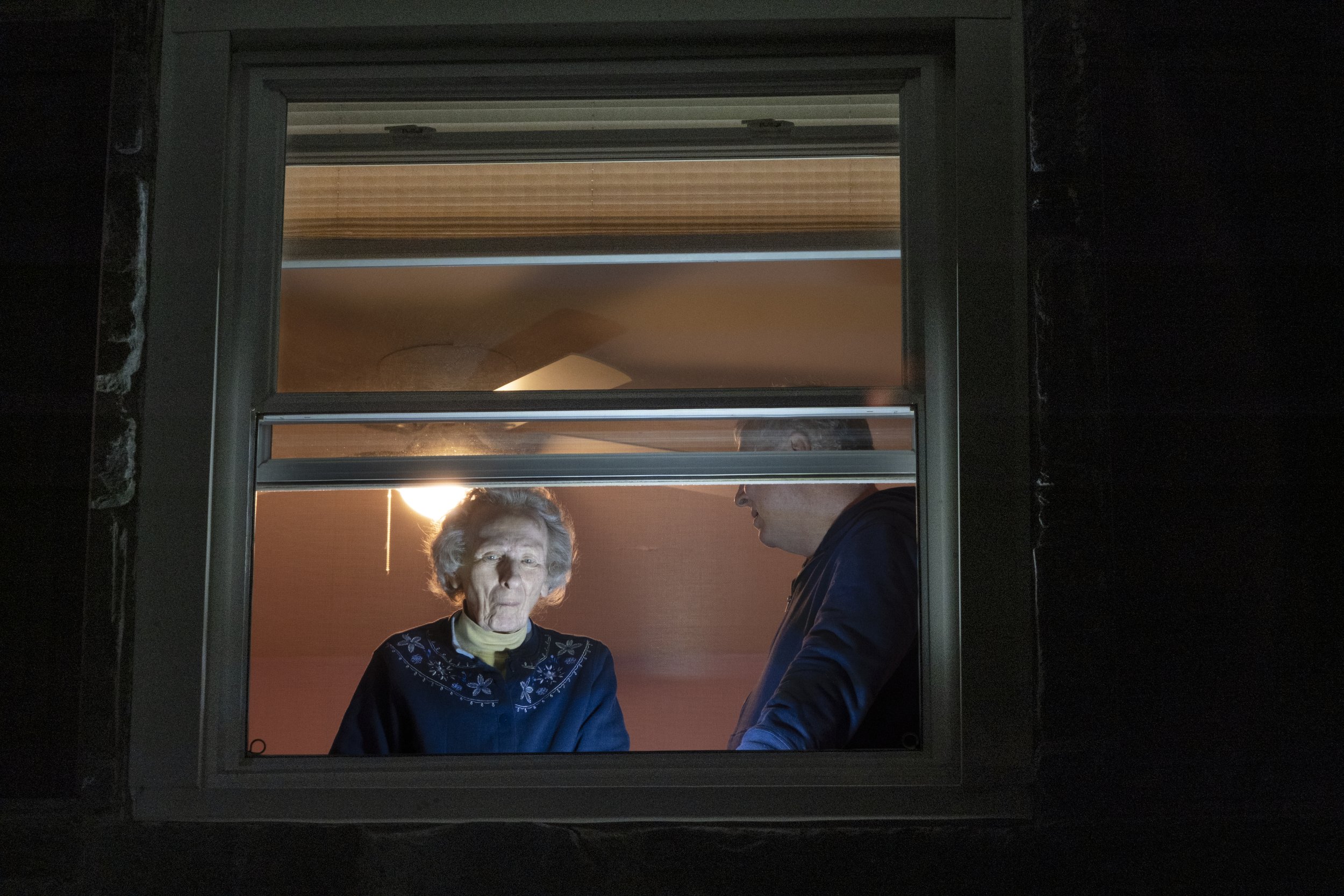
IT’S DARK OUTSIDE, from the series Between Then & Now, 2023. © Patricia McElroy

KEVIN IS THAT YOU, from the series Between Then & Now, 2023. © Patricia McElroy
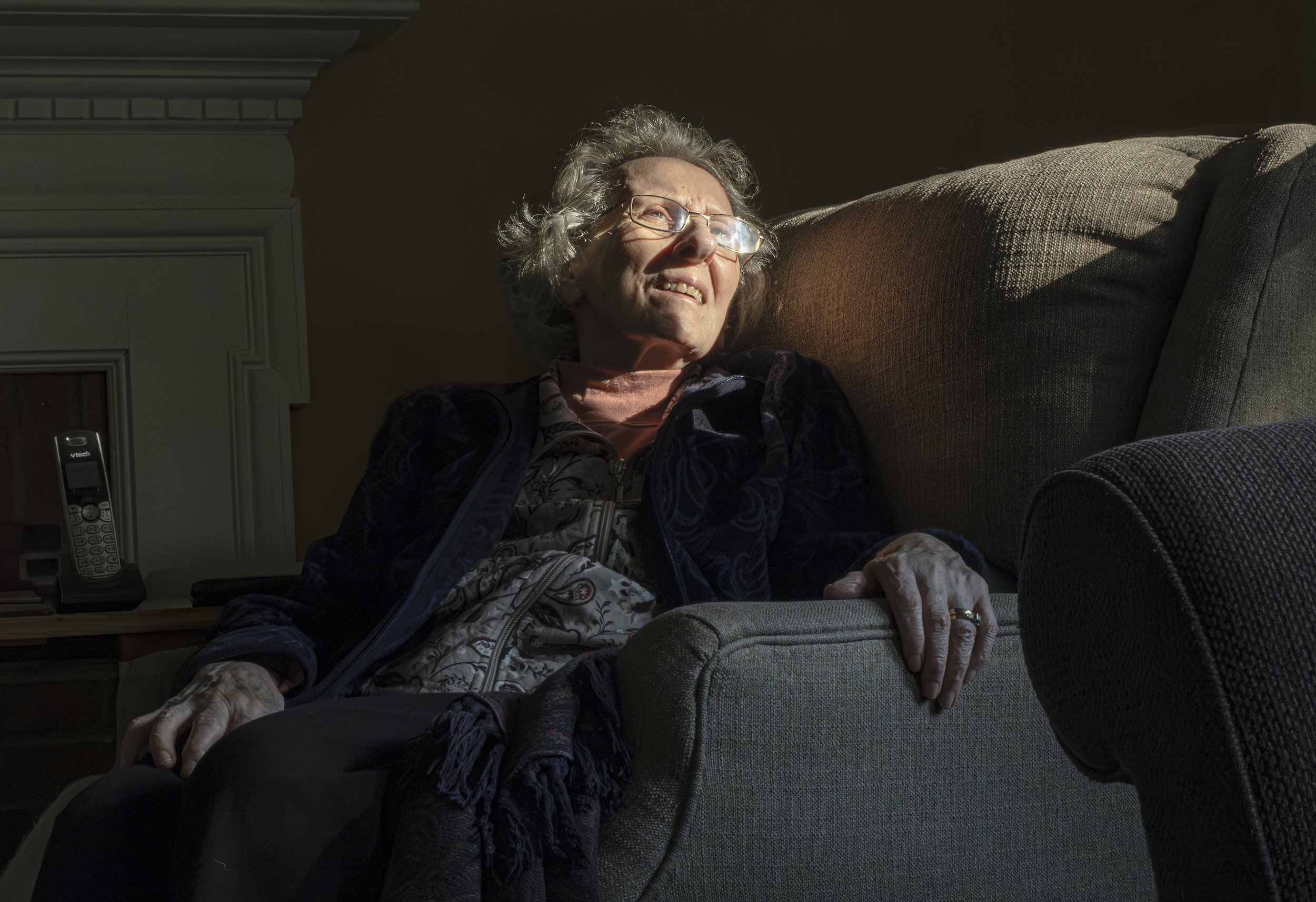
SOMETIMES THE LIGHT FROM WITHIN SHINES THRU, from the series Between Then & Now, 2023. © Patricia McElroy
McElroy has always been drawn to photography’s ability to preserve fleeting moments, revealing truths that may not be immediately apparent. “Each photograph is a mystery, a gift waiting to be unwrapped,” she says. Light plays a central role in her practice, as does simplicity in approach—she primarily works with natural light and a Fuji X-T4. Over the years, she has drawn inspiration from artists such as Sarah Moon, Sally Mann, Larry Sultan, and Nan Goldin, among others.
THE WRITTEN WORD, from the series Between Then & Now. © Patricia McElroy
SEEING THRU, from the series Between Then & Now, 2023. © Patricia McElroy
SHE SAVED EVERY ONE, from the series Between Then & Now, 2024. © Patricia McElroy
BOXED MEMORY, from the series Between Then & Now, 2024. © Patricia McElroy
PURGATORY, from the series Between Then & Now, 2023. © Patricia McElroy
MY WEDDING HER DRESS, from the series Between Then & Now, 2024. © Patricia McElroy
Currently, she continues to expand Between Then & Now, reflecting on her family's long history of migration. This ongoing project examines how identity is shaped by movement between places and generations. At its heart, it remains a meditation on love, loss, and the complex ties that bind us to those who came before.
Sushilla Kouwen
The Netherlands
IG: sushilla.nl | www.sushilla.nl
Sushilla Kouwen is a photographer whose work balances emotion and art, capturing the complexity of human connection, the beauty of nature, and the fleeting moments that define life. Her images explore universal themes such as transience, love, and loss, often drawing from deeply personal experiences. Through her photography, Kouwen seeks to evoke emotions, inspire reflection, and highlight the resilience of the human spirit.
SOLIVAGANT, 2020. © Sushilla Kouwen
Her photographs are distinguished by their poetic composition, attention to detail, and an intuitive use of light that adds depth and emotion to her work. Kouwen’s images often feature self-portraits or include family members, lending an intimate and authentic quality to her storytelling. She believes vulnerability is a source of strength and seeks to showcase the beauty found in sadness and resilience. Kouwen believes that grief and loss are not things to hide but rather moments that can bring deep beauty and growth.
Nature serves as another key inspiration for Kouwen, offering reflections of both strength and fragility. She draws connections between the cycles of the natural world and the human experience, exploring themes of time and transience. Her creative process is deeply intuitive and spontaneous, with ideas often sparked by her surroundings, music, films, or personal memories. At times, inspiration strikes in the middle of the night, resulting in images rich with personal symbolism and emotional resonance.
ATHAZAGORAPHOBIA, 2021. © Sushilla Kouwen
EXORCISM, 2021. © Sushilla Kouwen
METANOIA. © Sushilla Kouwen
ORPHIC, 2022. © Sushilla Kouwen
NYCTOPHILIA, 2023. © Sushilla Kouwen
KALOPSIA, 2022. © Sushilla Kouwen
Photography, for Kouwen, is not just a profession but a way of life. From the moment she picked up her father’s old Pentax camera at the age of sixteen, she felt a deep connection to the medium. Now, working primarily with Nikon cameras, she channels her creativity into her daily life, finding structure and balance in the process of crafting her visual narratives.
LAICITE, 2020. © Sushilla Kouwen
VIRIDITY, 2020. © Sushilla Kouwen
Sushilla credits artists such as Frida Kahlo, Annie Leibovitz, Erwin Olaf, and Salvador Dalí as major influences on her work. Kahlo’s self-portraits and willingness to confront personal pain resonate deeply, while Leibovitz’s intimate portraits and Olaf’s storytelling inspire her to explore new perspectives. Dalí’s surrealism also informs her experimentation, encouraging her to merge reality with imagination in her art.

MAESTRO, 2023. © Sushilla Kouwen

QUAINTRELLE, 2023. © Sushilla Kouwen

CYGNE NOIR, 2024. © Sushilla Kouwen

SPINE. © Sushilla Kouwen

MAGGOT BRAIN, 2024. © Sushilla Kouwen
Currently, Kouwen is exploring a personal project inspired by her grandfather and father, delving into themes of loss, love, and identity. This body of work reflects her ongoing quest for self-discovery, using photography to unravel family history and its influence on her life. She hopes to expand this series, layering new stories over existing ones and continuing to explore how her personal experiences connect with those of others.
ATLAS, 2023. © Sushilla Kouwen
AONARAN, 2024. © Sushilla Kouwen
GUARDIAN. © Sushilla Kouwen
Sushilla’s award-winning work is a testament to her ability to transform personal vulnerability into powerful art. Her photographs tell stories that remind viewers of the strength in embracing emotions and the beauty that can arise from life’s most challenging moments. She emphasizes that even in the darkest moments, beauty can be found, reflecting the resilience of the human spirit.
Dai Nakamura
Japan
IG: @nakamura_1970
Dai Nakamura, born in Hokkaido in 1970, is a photographer whose work is deeply rooted in Japanese aesthetics and philosophy. Influenced by his mother, a calligrapher, he developed an early passion for the arts. Cinema played a pivotal role in shaping his artistic vision—his fascination with film began after watching Star Wars in elementary school, later inspiring him to pursue filmmaking. In 1991, he moved to the United States to study, but an encounter with black-and-white photography in a journalism class redirected his path. Captivated by the medium, he transferred to the Rhode Island School of Design, graduating in 1997. That same year, he became an assistant to Hiroshi Sugimoto in New York, a turning point that solidified his dedication to photography.
NEIGHBORING BOYS, from the series The Solitude Standing, 1997. © Dai Nakamura
Nakamura’s work is profoundly influenced by the Japanese concepts of mono no aware and wabi sabi. Mono no aware captures the fleeting, transient nature of life, evoking deep emotions in response to change. Wabi is an appreciation of impermanence and simplicity, while sabi finds beauty in aging and imperfection. These philosophies underpin his preference for monochrome photography, which he sees as a way to strip away distractions and reveal the essence of a subject. “By projecting things into a world of tones ranging from black to white, all unnecessary information is stripped away, allowing me to get closest to the sensations I have imagined,” Nakamura explains.
His photographic themes revolve around the delicate emotions hidden in everyday life, the coexistence of contradictions within a single moment, and the relationship between humanity and nature. The Solitude Standing series first sharpened his interest in capturing the essence of human existence. Later, in Broadway Tavern, he continued to explore emotions embedded in the everyday. His Sakura series epitomizes his fascination with contrasts—the extraordinary within the ordinary, the inevitable decline within moments of glory, and the brilliance of life even in its fading stages.
AT THE END OF EACH DAY, from the series The Solitude Standing, 1997. © Dai Nakamura
MR. BROWNIE, from the series The Solitude Standing,1996. © Dai Nakamura
NORMAN ROCKWELL, from the series The Solitude Standing,1997. © Dai Nakamura
ALICE IN WONDERLAND, from the series The Solitude Standing,1997. © Dai Nakamura
USUAL MORNING, from the series The Solitude Standing,1996. © Dai Nakamura
LONG TIME REUNION, from the series The Solitude Standing,1996. © Dai Nakamura
MR. ARCHER, from the series The Solitude Standing,1997. © Dai Nakamura
“By projecting things into a world of tones ranging from black to white, all unnecessary information is stripped away, allowing me to get closest to the sensations I have imagined.”

QUIET AFTERNOON, from the series The Solitude Standing, 1996. © Dai Nakamura

60 ALL AFTER LUNCH TIME, from the series The Solitude Standing, 1997. © Dai Nakamura

HARMONY, from the series The Solitude Standing, 1996. © Dai Nakamura

WITH FRIENDS, from the series The Solitude Standing, 1996. © Dai Nakamura

GENERATION AFTER GENERATION, from the series The Solitude Standing, 1996. © Dai Nakamura
Nakamura’s recent work has focused on cityscapes, particularly the evolving interplay between urban structures and the sky. By capturing road signs, bridges, and towering cranes in motion, he introduces a dynamic, ephemeral quality to his images. In parallel, he has been documenting traditional Shinto shrines, a project that delves into Japan’s spiritual foundations. “Shintoism sees gods in all things—trees, stones, mountains—and I want to capture that solemn presence in my images,” he says. Additionally, a more personal project has emerged—photographing his family, particularly his mother. While he has never felt drawn to documenting those closest to him, the pandemic shifted his perspective, prompting him to explore intimacy and connection in new ways.
LONG DAY, from the series The Solitude Standing, 1996. © Dai Nakamura
ANOTHER CUP OF COFFEE, from the series The Solitude Standing, 1996. © Dai Nakamura
Though trained under Hiroshi Sugimoto, Nakamura acknowledges a diverse range of influences, including Paul Strand, Ansel Adams, Diane Arbus, Sebastião Salgado, and Jerry Uelsmann, as well as painters such as Joan Miró, Salvador Dalí, and Jackson Pollock. His creative process is methodical; he envisions an image in his mind before pressing the shutter. “Rather than searching for a fleeting moment, I already have an atmosphere and emotion in mind. The photograph is complete before I even begin shooting,” he notes.
STANDING TALK, from the series The Solitude Standing, 1997. © Dai Nakamura
Over the years, Nakamura has transitioned from exclusively using analog cameras to incorporating digital photography and printing techniques. Despite this evolution, his core approach remains unchanged—seeking to capture the profound, often overlooked emotions embedded in everyday life. He ultimately hopes his images will evoke a timeless sense of humanity. “I think humans are lovable,” he reflects. “I want to take photographs that capture that feeling from various angles, capturing moments that will make people feel even more lovable when they look at them 20 or 30 years from now.”
Author: Kseniia Pochernei. March, 2025
article
Voyeur’s Vision: Semiotic Explorations in Visual Language and Photography
Introduction:
Liz Wells’ assertion regarding ‘coded’ and ‘decoded’ images draws from the notion that photography functions as a visual language (Wells 2021, p.48). Much like any language, it requires systematic study and instruction to both convey and interpret its messages. Vilém Flusser’s concept of technical images further underscores the idea that images were primarily crafted to help humanity navigate the complexities of the world (Flusser 2000. p14). If every image carries a message, then the purpose of written texts is to elucidate the meanings embedded within these images. These perspectives guide us toward an exploration of semiotics, a field teeming with diverse tools and methodologies.
Michel Foucault’s theory of discourse provides a potent framework for scrutinizing what constitutes photographic discourse (Hook 2001, p 521-547). Hence, this journal delves into the concept of semiotics, dissected through a voyeuristic lens. It is proposed that all artists inherently adopt a voyeuristic stance as they perpetually observe, analyze, and envision future artistic creations. This voyeurism is not confined to photography but extends to art in its entirety. The history of photography offers numerous instances where the act of seeing plays a main role in various analytical endeavours. These range from early physical explorations like X-rays to Eadweard Muybridge’s groundbreaking images of horses in California and the psychoanalytical interpretation of human nature based on facial features (Braun 2010, p 21-29).
Sigmund Freud’s concept of scopophilia reveals that the inclination to indulge in voyeurism is inherent from childhood, where individuals unconsciously strive to peek into forbidden spaces, such as their parents’ rooms (Freud 1953). Erik Erikson noted that the permission to explore uncharted territory is a hallmark of great men, especially intellectual leaders who grant scopophilic permission (Erikson 19680). They authorize people to look, see, and understand what was formerly forbidden or unknown.
Although the innate human desire for forbidden observation remains unchanged, the means by which we fulfil it have evolved with technological advances. This essay seeks to illustrate how various artists employ a voyeuristic perspective and how they encode their images and the reasons behind their choices. The exploration commences with an in-depth analysis of Sophie Calle’s work, in which she positions herself as a spy and subsequently harnesses her experiences to create new projects based on feedback and responses. Then delve into the technical and compositional aspects of Miroslav Tichý’s photography. Marina Abramović’s art, known for its performative elements, shifts the focus from the act of seeing to that of being seen. In conclusion, this work showcases the unique artistic journeys of three distinct artists who incorporate voyeurism as a central element in their semiotic study, all within the context of Liz Wells’ contemplation on photographic images.
Sophie Calle
Sophie Calle, an artist whose career delves into morally complex realms, blurs the boundaries between public and private, self and other, and reality and fiction. Her exploration of self-portraiture is closely entwined with the discourse of identity. Central to her work is the use of voyeurism as a tool to delve into forbidden aspects of society. Projects often involve nudity and intimate narratives drawn from personal experiences, such as reflections on her initial sexual encounter, documented through both photography and text.
In projects like Suite Venitienne (1980), where she stalked strangers, Calle asserted her interest lay not in the individuals but in the act of following, which provided her with a sense of satisfaction. The deliberate use of blurred, low-quality, and improperly cropped images serves to underscore her conceptual message and functions as a code, acting as an index. She consciously employs storytelling techniques, inviting viewers to feel the story not only through the angle of view but also by incorporating the image of Henri B., who recognized and prohibited her from taking his photograph, eliciting emotions in the viewer (Calle 2003, p 91).
Suite Vénitienne by Sophie CalleImages and text copyrighted and provided courtesy of the artist; published by Siglo, 2015
Copyright Sophie Calle 2010 courtesy of Steidl and Hasselblad Awards 2010
One prominent example of Calle’s approach is evident in True Stories (1988-2003), an ongoing compilation combining autobiographical text and photographs.
This work recounts improbable and often disturbing events with a stylistic and emotionally restrained narrative, skillfully portraying the encroachment of dis- aster into everyday life.
Calle’s detachment adds poignancy to her descriptions, infusing narratives of violence and tragedy with an impactful charge akin to Roland Barthes’ photographic punctum (Barthes 1980, p.43-47). True Stories (1988-2003) also reveals gendered dimensions of violence, contributing to contemporary discussions surrounding women’s trauma, its narration, and believability. Calle’s encounters with violence are intricately connected to her identity as a woman, inseparable from her artistic ambitions, inviting a feminist interpretation that sheds light on the complexities of blending fact and fiction in her work (Carr 2004, p 330).
Consistently manipulating the dynamics of visibility and various subject positions in her projects, Calle introduces distinctive relationships between observer and observed. In The Sleepers (1979), she challenges and blurs social and personal boundaries, adopting a privileged position as an observer reminiscent of Foucault’s panoptic gaze in Discipline and Punish (Foucault 1994, p 679-709). The camera’s presence is crucial, serving as a tool with assumed evidentiary power and the ability to visually conceal the identities of Calle’s subjects. As Susan Sontag notes, photography is an act of appropriation, a means of establishing a powerful relationship with the world (Sontag 1933). In typical fashion, Calle immerses herself in random situations, yet from the outset, she exercises meticulous control, reporting on them systematically and with a cool, detached style. The Sleepers (1979) exemplifies Calle’s method, showcasing her deliberate and calculated approach to her projects.
The Sleepers (Antoine Gonthier, Twentieth Sleeper, and Patrice X., Twenty-First Sleeper), 1979
Miroslav Tichý
Miroslav Tichý, a Czechoslovakian photographer, emerges as a provocative counterpoint to contemporaries like Calle, fully immersing himself in a voyeuristic methodology that defined his unique approach to photography. As a self-imposed outsider, Tichý exhibited ingenuity by crafting his own camera from discarded materials, dedicating decades to the covert exploration of the essence of women through his lens. Despite his formal education at the esteemed Academy of Fine Arts in Prague, where he delved into the portrayal of nude women in paintings, Tichý’s reverence for feminine beauty appears more as a recurring motif with deep roots in art history than a deliberate aesthetic pursuit (Ebony 2010). His intimate connection to vernacular aesthetics permeates every facet of his creative process, manifested in deliberate technical flaws, a distinct photographic technique, and an almost obsessive relationship with his subjects—a true embodiment of the etymological essence of an amateur as ‘one who loves’ (Lenot 2009).
Miroslav Tichý Untitled, n.d. © Foundation Tichy Ocean
Miroslav Tichý. https://www.lafabrica.com/press-releases/madrids-museum-of-romanticism-presents- the-work-of-the-czech-photographer-miroslav-tichy/
Tichý’s photographs, marked by intentional spots, blurs, unconventional angles, scratches, and deliberate underexposure, boldly challenge conventional standards, offering a poignant commentary on the inherently subjective nature of ‘good’ photography (Foley-Mendelssohn 2011). While Tichý’s lens often fixated on women’s legs and backsides, potentially influenced by voyeuristic tendencies or constrained by technical limitations, the unconventional compositions frequently omitted subjects’ heads, suggesting an inherent inability or refusal to conform to traditional compositional norms. Tichý’s eccentricities extended beyond his photographic work to his daily visits to local pools, where he captured moments that often evoked disdain from subjects who perceived him as the eccentric town figure, suspecting his camera to be a mere facade (Rosenberg 2010). The documentary by Mr. Buxbaum further underscores the palpable chasm between Tichý and his subjects, emphasising their perceived impossibility, symbolised by the recur- ring motif of a fence in his frames (Buxbaum 2006).
Despite the controversy surrounding his methods, Tichý viewed his photographic process as an ongoing and pleasurable exploration of the world, underscoring the crucial role of light in his creative endeavours. His unconscious, unfiltered approach to photography inadvertently mirrored his distinct vision and a determined commitment to perceive the world through his own, unconventional lens. In his eyes, every day offered an opportunity for learning and pleasure, with each captured image serving as a window into his unique perspective. Tichý’s mantra that “photography is paint with light” encapsulates his deep connection to the medium—a tool that, for him, wasn’t just a means of capturing images but a vehicle for exploring and understanding the world on his own terms (Buxbaum 2006).
Marina Abramovic
Marina Abramovic is an artist who elevated the concept of voyeurism in art by seamlessly integrating the intimacy of private space into the public sphere. In an interview with Germano Celant, she expressed her desire for more interaction from the public, driven by the belief that as we move towards a future saturated with electronic devices, opportunities for genuine human connection may diminish (Celant 2001, p 10-13). As a proponent of ‘pure energy,’ Abramovic creates art not only to give but also to exchange. Her performances serve as a platform for analysing not just audience reactions but also acknowledging that many attendees partake not merely to witness her art but to actively become a part of it.
Her Transitory Objects (1989- still in progress) project utilises everyday items as tools to trigger experiences, emphasising that these objects lose their conventional meaning after the performance, transforming into pieces of art. The idea lies in demonstrating that the power lies not within the objects themselves but in their utilisation. Abramovic reinforces the significance of both the object and the performance by establishing rules for spectators to follow, underscoring that despite evolving performances, the core idea of energetic exchange remains constant (Celant 2001, p 10-13).
The House with the Ocean View at Sean Kelly, New York
Living installation November 15 - 26, 2002
Courtesy: Sean Kelly, New York
In The House of the Ocean View (2002), Abramovic gathered strangers in a shared space to witness her fasting for 12 days without speaking. Perched on a platform of three open-faced rooms fixed to the gallery’s back wall, the artist, surrounded by the odd presence of a metronome and ladder-rungs made of knives, engaged in a performance devoted to a kind of meditation. The house, lacking any privacy, symbolically challenged the notion of personal space.
“Abramovic takes a shower soon after I walk into the Sean Kelly gallery for the first time. She stands with her arms outstretched, and lets out a silent scream. After a very long and very slow drying procedure, she takes a pee. I get a bit embarrassed, and worry that she’s going to take a shit too but then I realize this is unlikely: she hasn’t eaten in seven days. (Westcott 2003, pp 129)”
Marina Abramovic skillfully incorporates semiotics and symbols into her performances, intertwining her emotions with personal narratives. One such poignant symbol is a metronome, endowed with unique significance. This metronome, while audibly ticking and seemingly keeping time, paradoxically serves to regulate moments of profound silence. Throughout a substantial portion of the performance, Abramovic sustains the rhythmic pulse of the metronome. The curious inclusion of this object in a performance centred around a form of meditation, coupled with the ladder-rungs crafted from knives, evokes memories of the artist’s unsuccessful foray into music lessons (Stiles 2008).
Notably, in projects like Cleaning the House (1995) and Cleaning the Mirror (1995), she uses art as a language to draw attention and prompt contemplation about war. By washing away bloody bones and skeletons, symbols of death, she appears to atone for the catastrophic events of ethnic cleansing, torture, and murder perpetrated by Serbs. The act of cleaning, besides its literal meaning, signifies eradicating and obliterating, emphasising the need for collective responsibility. In Cleaning the Mirror (1995), Abramovic incorporates elements of sacred contact, invoking ancient Slavic traditions where the bones of the deceased are washed. This ritual, prevalent in Montenegro, Abramovic’s paternal ancestral home, reflects her deep emotional and historical ties to the land. Additional iterations of the performance involve nudity, a skeleton moving to the rhythm of her breath, and attempts at psychic communication with objects, bridging the gap between life and death. The symbolism in Cleaning the Mirror (1995) delves into both ancient vanitas themes and mod- ern explorations of the interplay between life and death, aligning with Sigmund Freud’s theories on human nature and desire (Stiles 2008).
Marina Abramovic, Cleaning the mirror, 1&11 (1995). Performance and video stills. Abramovic applies shamanic techniques such as Othering, cognitive reversal through her own agency, a subjective experience, soul flight and vision quests (Illustration Abramovic 1998, p. 243).
Conclusion:
Overall, the critical catalogue embarked on a journey through the lens of three distinct artists—Sophie Calle, Miroslav Tichý, and Marina Abramovic— to explore the theme of voyeurism within the realm of photography and art. Grounded in Liz Wells’ concept of ‘coded’ and ‘decoded’ images, the catalogue delves into the intricate world of semiotics, where each artist becomes a voyeur, perpetually observing, analyzing, and encoding their images with layers of meaning.
Sophie Calle’s exploration of voyeurism is intertwined with the discourse of identity, blurring the boundaries between public and private, and reality and fiction. Through projects like Suite Venitienne (1980) and True Stories (1988-2003), she employs deliberate techniques such as blurred images and calculated compositions to convey conceptual messages, inviting viewers to engage with her narratives emotionally and intellectually. Calle’s voyeuristic gaze challenges and blurs social and personal boundaries, adopting a privileged position as an observer, reminiscent of Michel Foucault’s panoptic gaze.
Miroslav Tichý, in contrast, immerses himself in a unique and unconventional approach to voyeurism, crafting his own cameras and capturing intimate moments of women from the shadows. His deliberate technical flaws and eccentricities challenge conventional standards, offering a poignant commentary on the subjective nature of ‘good’ photography. Tichý’s work, while potentially controversial, reflects his deep connection to the medium, using it as a tool to explore and understand the world on his own terms.
Marina Abramovic elevates voyeurism to a new level by seamlessly integrating the intimacy of private space into the public sphere. Through projects like Transitory Objects (1989- still in process) and The House of the Ocean View (2002), Abramovic creates opportunities for genuine human connection and interaction, challenging conventional notions of personal space. Her use of symbols and semiotics in performances like Cleaning the House (1995) and Cleaning the Mirror (1995) adds layers of meaning, prompting contemplation about war, collective responsibility, and the interplay between life and death.
Each artist, in their unique way, contributes to the overarching exploration of voyeurism within the context of Liz Wells’ contemplation on photographic images. They reveal the diverse ways in which artists encode their images, employing voyeuristic perspectives as a central element in their semiotic study. From the deliberate blurring of boundaries by Calle to Tichý’s unfiltered exploration and Abramovic’s seamless integration of private and public spaces, the catalogue showcases the rich and multifaceted ways in which voyeurism permeates the world of art and photography.
In conclusion, the critical catalogue invites readers to contemplate the complexities of visual language, the act of seeing, and the encoding of meaning within images. Through the lens of these artists, we are prompted to question, interpret, and engage with the voyeuristic elements embedded in the visual narratives, ultimately expanding our understanding of the intricate relationship between art, voyeurism, and the semiotics of photography.
References
Abramovic, M. (2.07.1995). Museum of Modern Art, Oxford
Abramovic, M. (1994). Marina Abramovic: Biography, Ostfildern bei Stuttgart : Cantz Abramovic, M. (2001). Marina Abramovic: Public Body, Edizioni charta, Milano
Allen, D. W. (1974). The fear of looking: or, Scopophilic-exhibitionistic conflicts. Bristol, England: John Wright and Sons Ltd.
Bate, D. (2009). Photography: The Key Concepts (2nd ed.).
Barthes, R. (1980). Camera Lucida: Reflections on Photography. London: Cape Brenner, N. (1994). Foucault’s New Functionalism. Theory and Society, 23(5), 679-709. Burgin, V. (1982). Thinking photography. MACMILLAN EDUCATION LTD, London
Buxbaum, R. (2006). Miroslav Tichy; Tarzan Retired. DVD, 52 minutes, 2006 [film] / 2008 [DVD], http://www.worldstar.sleeping-tiger.com
Calle, S. (2009). In Conversation with Sophie Calle. In A. Whitechapel Gallery. Calle, S. (2003). Sophie Calle: m’as-tu vue. Prestel, London, Munich.
Cambridge Dictionary. (n.d.). Voyeurism. Retrieved from https://dictionary.cambridge.org/diction- ary/english/voyeurism#
Carr, J. (2003). The Disaster Artist: Sophie Calle’s “histoires vraies”. Retrieved from https://white- hotmagazine.com/articles/review-sophie-calle-true-stories/2216
Erikson, E. H. (1968). Identity: youth and crisis. New York: Norton.
Erkan, A. (n.d.). Between the Sheets: ‘Lamination’ and Sophie Calle’s The Sleepers https://www.lancaster.ac.uk/luminary/issue3/Issue3article6.htm#11
Ebony, D. (2010). Miroslav Tichy. Online access: https://www.artnews.com/art-in-america/aia-reviews/miroslav-tichy-2-60546/ Freud, E. L. (Ed.). (1960). Letters of Sigmund Freud. New York: Basic Books.
Freud, S. (1953a). Three essays on the theory of sexuality (1901-1905), I. The sexual aberrations. The standard edition of the complete psychological works of Sigmund Freud.
Flusser, V. (2000). Towards a philosophy of photography, Reaktion Books Ltd, London. Foley-Mendelssohn, D., (2011). Portfolio: Miroslav Tichy. Online access: https://www.theparisreview.org/blog/2011/08/08/portfolio-miroslav-tichy/#:~:text=The%20
pictures%20are%20spotted%2C%20blurred,rolls%2C%20sandpaper%2C%20and%20tooth- paste.
Foucault, M. (1994). Discipline and punish : the birth of the prison, Penguin, London.
Hand, J. (n.d.). Sophie Calle’s voyeuristic portraits of hotel rooms. Retrieved from https://www. youtube.com/watch?v=V5yLOcp-azI
Hook, D. (2001). Disorders of Discourse.
Krauss, R. E. (n.d.). Truth. Retrieved from https://www.textezurkunst.de/en/articles/tzk-66- krauss-truth/
Lenot, M., (2009). The invention of Miroslav Tichy. Société française de photographie, France. Metzl, J. M., Phillips, S. (2004). Voyeur Nation? Changing Definitions of Voyeurism, 1950–2004. Mondino, J. B. (2003). Sophie Calle Prestel Book.
Rosenberg, K. (2011). An Ogling Subversive With a Homemade Camera. Online access: https:// www.nytimes.com/2010/02/12/arts/design/12photos.html
Sontag, S. (2002). On Photography. London: Penguin.
Stils, K., Biesenbach, K., Iles, C. (2008). Marina Abramovic. Phaidon, London Sturken, M., & Cartwright, L. (2009). Practices of Looking.
Phillips, S.S. (2010). Exposed: voyerism, surveillance, and camera.Tate, London Thomas, J. (2000). Reading images. Basingstoke: Macmillan
Westcott, J. (2003). Marina Abramovic’s “The House with the Ocean View”: The View of the House from Some Drops in the Ocean. TDR
Voyeurism. (n.d.). In Cambridge Dictionary. Retrieved from https://dictionary.cambridge.org/dic- tionary/english/voyeurism#
photo-artnews
Photo-Art News
The Enduring Legacy of Edward S. Curtis
and His Vision of Indigenous North America
A newly released edition of The North American Indian: The Complete Portfolios by Taschen revives the monumental photographic work of Edward S. Curtis, who dedicated his life to documenting Indigenous cultures of North America. Spanning over two decades from 1907 to 1930, Curtis produced more than 40,000 images and valuable ethnographic records of over 80 tribes. His ambitious project captures not only photographs but also audio recordings of songs, languages, and oral traditions that might have otherwise been lost.
The new edition presents over 700 carefully selected photographs in a beautifully bound volume, offering a profound reflection on North America's Indigenous heritage. Although Curtis’ work is widely praised for its artistic and historical value, it has also faced criticism for romanticizing Native cultures. Some of his scenes were staged, and subjects sometimes wore garments not reflective of their daily life, raising important debates about authenticity and representation.
Nevertheless, Curtis' portraits convey a deep sense of dignity and resilience, capturing a pivotal moment in Indigenous history. This collection stands as both a historical document and an artistic achievement, offering insight into cultures undergoing significant change at the turn of the 20th century.
Photo credit: © Taschen
Photo credit: © Taschen
Elisa Miller
United Kingdom
https://elisamillerstudio.com/
London-based photographer Elisa Miller has carved a niche in the world of visual storytelling by combining fine art with conceptual narratives. Her work delves deeply into themes of identity, self-perception, and societal expectations, often from a distinctly female perspective. Bold, colorful, and thought-provoking, her images challenge stereotypes and offer a window into the complexities of human experience.
LIKE SOMEONE IN LOVE, from the series Like someone in love, 2022. © Elisa Miller
Miller’s photography has been widely celebrated, with her work featured in prestigious exhibitions across Europe and the USA, as well as publications like Lens Magazine, Aesthetica, All About Photo, and Life Framer. Her accolades include “Photographer of the Year” at the Julia Margaret Cameron Awards (2023) and “Fine Art Photographer of the Year” at PX3 Prix de la Photographie Paris (2022), cementing her reputation as a leading voice in contemporary photography.
Her approach is rooted in storytelling, using cinematic visuals and intricate details to create evocative narratives. “My work is deeply personal,” she explains, “but I always leave space for the viewer to interpret it in their own way. At its core, it’s about storytelling—reflecting on how our past, our choices, and society’s expectations shape us.”
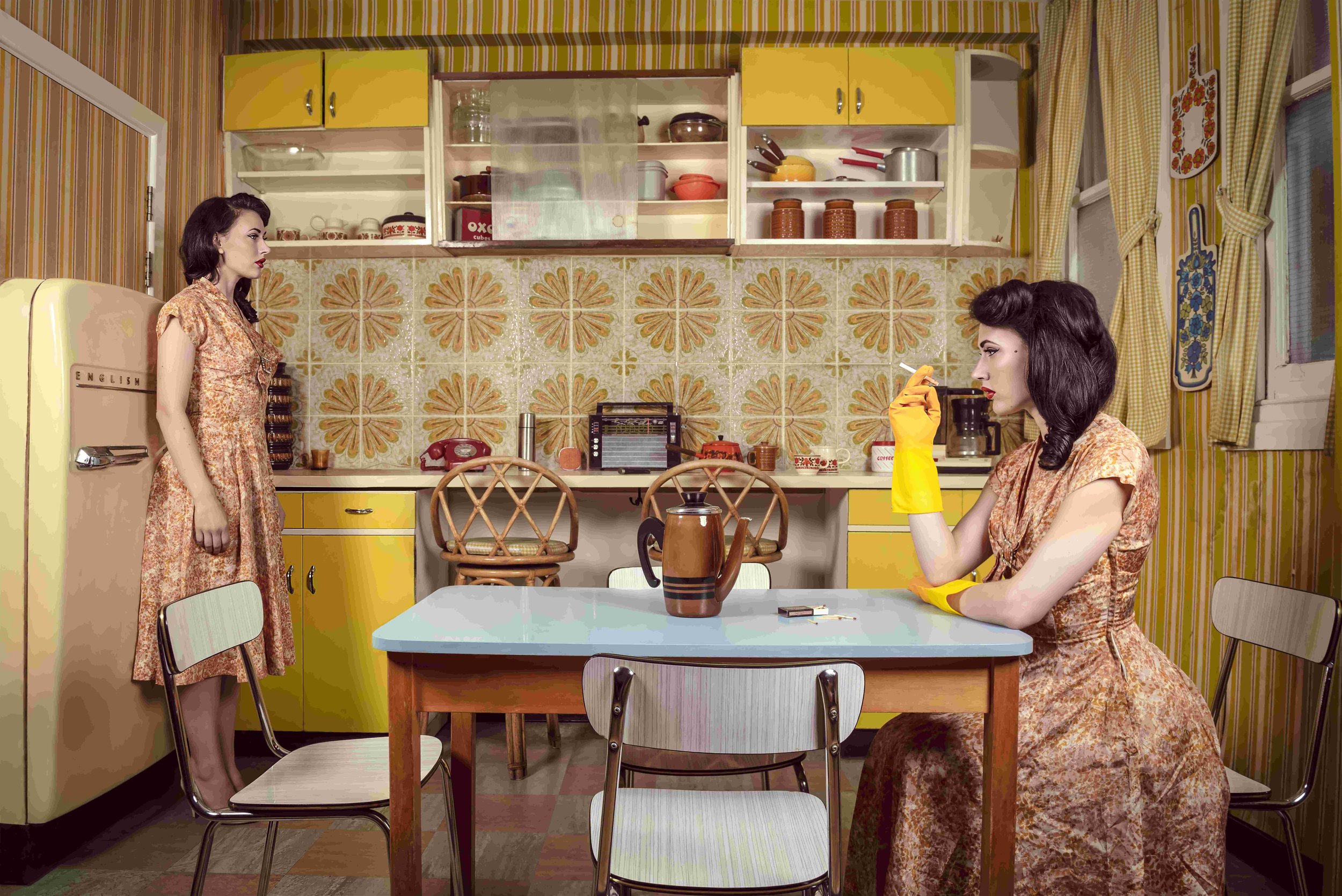
CIGARETTE FOR BREAKFAST, from the series Alarm Call, 2022. © Elisa Miller

MEMORY, from the series Like someone in love, 2022. © Elisa Miller

I WAKE UP SCREAMING, from the series Murder, my sweet, 2023. © Elisa Miller
Miller’s creative process is meticulous and introspective. She begins with an idea or theme, often inspired by her own reflections on life, mental health, and the pressures women face. After extensive research, writing, and sketching, she carefully scouts locations, selects props, and casts models who can embody her vision. Every detail is considered, from wardrobe to lighting, resulting in cinematic and vibrant compositions that are as visually striking as they are emotionally resonant.

O' SILENT NIGHT, from the series Eye of the beholder, 2024. © Elisa Miller

THE BEAUTY CLOCK, from the series Eye of the beholder, 2024. © Elisa Miller
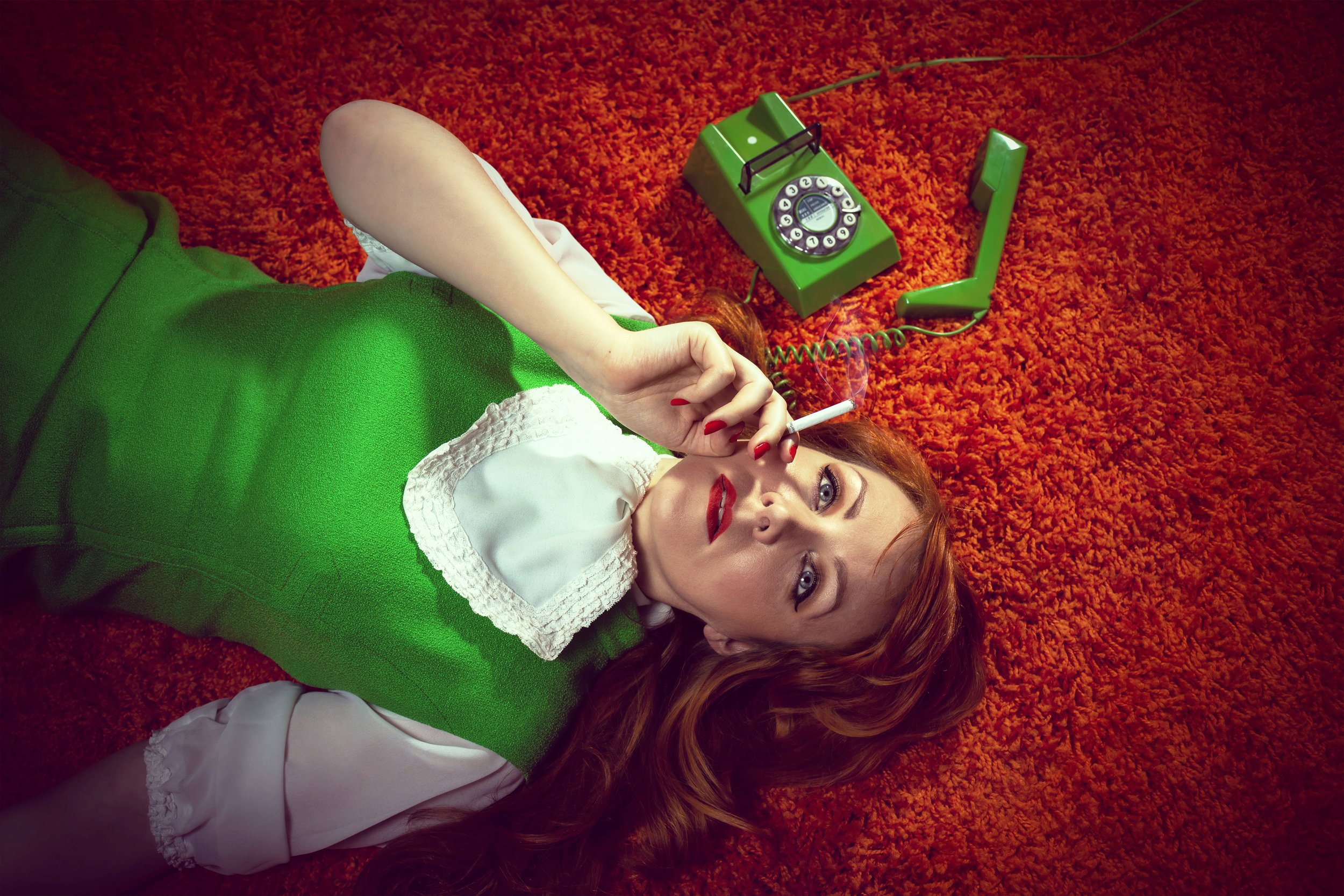
CONTACT (LOST), from the series Contact, 2021. © Elisa Miller
Her ongoing series, The Other, explores the societal roles and expectations imposed on women. It delves into the metaphorical masks people wear to conform and the inner struggles of self-judgment and external pressures. “At its core, the series reflects how we can be our own harshest critics, limiting ourselves through internalized expectations,” says Miller. “For me, The Other symbolizes this shadow self—yearning for authenticity beneath the weight of imposed roles.”
Another current project, On The Road, examines the theme of domestic violence, a subject Miller approaches with sensitivity and emotional depth. These works aim not only to challenge but also to inspire viewers to reflect on their own lives and the broader societal narratives at play.
Miller’s passion for photography dates back to her childhood. “I’ve loved storytelling and art since I was a kid. As a teenager, I wanted to be a photographer, but I couldn’t afford a camera,” she reflects. Instead, she channeled her creativity into painting with oils until years later, after moving to London, she finally bought a camera. “At first, it sat in a closet because I found it intimidating. But eventually, I started experimenting—first in Victorian cemeteries (the goth in me loved that) and then with models. That’s when I realized I wanted my photos to have meaning, to tell a story.”
Influenced by surrealist painters like Magritte and filmmakers such as Hitchcock and David Lynch, Miller’s work often incorporates the aesthetic of the 1950s. Her images are richly layered, blending classical art and cinematic influences to create immersive narratives that resonate with viewers.
TORERO, from the series Murder, my sweet, 2023. © Elisa Miller
THE SECRET BEYOND THE DOOR, from the series Murder, my sweet, 2023. © Elisa Miller
SHADOW OF A DOUBT, from the series Murder, my sweet, 2023 © Elisa Miller
THE PARADOX OF CREATION, from the series The many faces of Marie, 2021. © Elisa Miller

A NEW BEGINNING, from the series Dolly’s Diner, 2022. © Elisa Miller

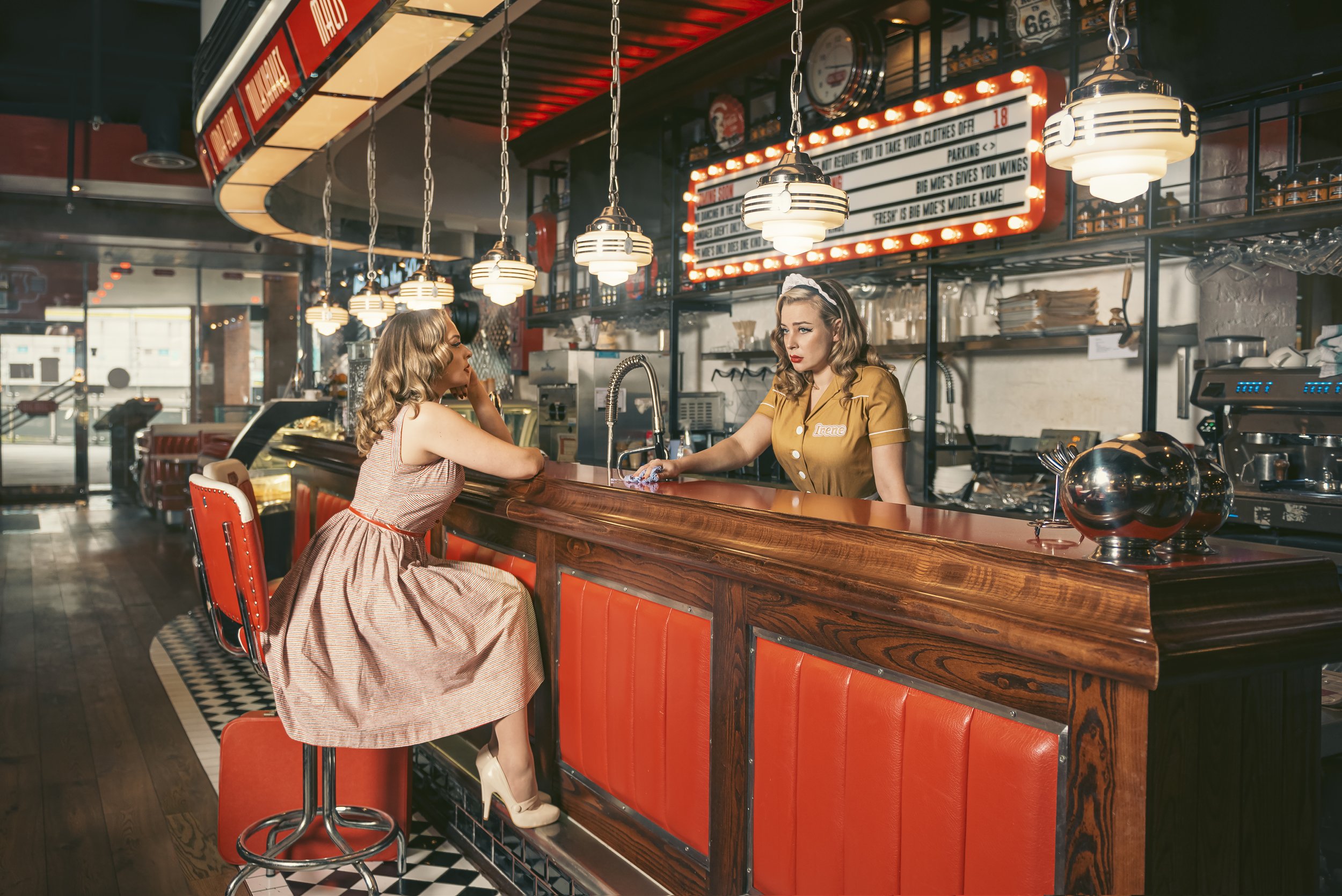
DOLLYS DINER, from the series Dolly’s Diner, 2022. © Elisa Miller


A LETTER TO MY YOUNGER SELF, from the series Dolly’s Diner, 2023. © Elisa Miller

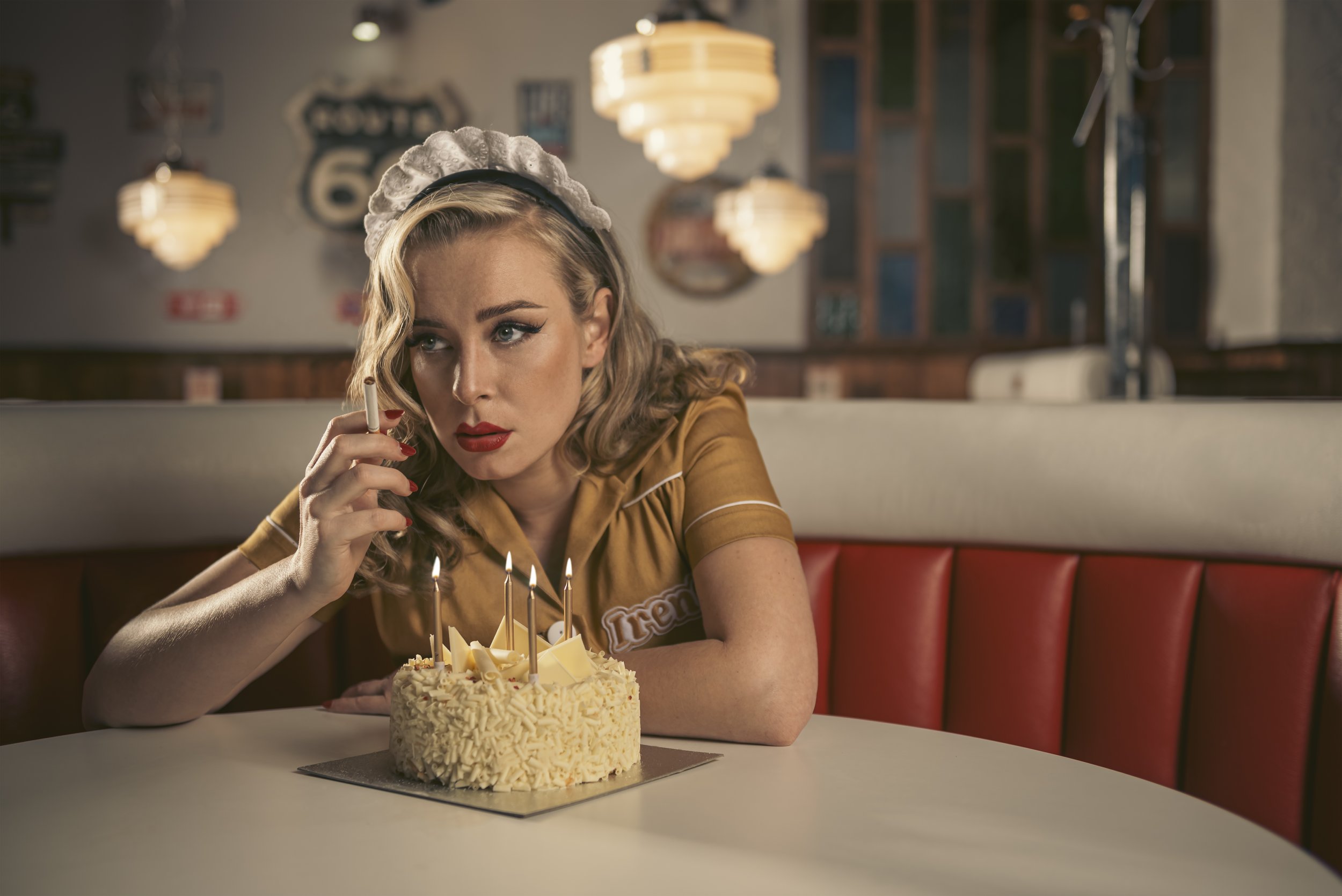
ANNIVERSARY, from the series Dolly’s Diner, 2023. © Elisa Miller


CASTING CALL, from the series Dolly’s Diner, 2023. © Elisa Miller


HOLLYWOODLAND,from the series Dolly’s Diner, 2023. © Elisa Miller

“It’s about self-emancipation and authenticity.”
ALARM CALL, from the series Alarm Call, 2022. © Elisa Miller
Looking ahead, Miller aspires to expand her presence in the art world by collaborating with galleries and participating in major art fairs, including Photo London and Paris Photo. “The world remains a challenging place, particularly for women,” she notes. “Through my work, I hope to uncover and share stories that spark change, even in small ways.”
Her philosophy can be summarized in her own words: “The most important lesson I’ve learned is to trust your instincts. Stay true to your vision, but don’t be afraid to let it evolve. It wasn’t until I started showing myself in my work that people began to connect with it.”
Kseniia Antipina
Germany
https://germenevtika-art.com/
Kseniia Antipina is a Berlin-based photographer whose surreal images invite viewers into a world where emotions, society, and fantasy intertwine. Born in a remote town without exposure to art, Antipina’s creative journey began when she discovered a passion for capturing moments with a camera. Her academic background in history and painting, followed by studies in graphic design, laid the foundation for her unique approach to photography. Since moving to Berlin in 2017, staged photography has evolved from a personal hobby into her primary artistic pursuit.
THE ICY STARES SEND CHILLS DOWN MY SPINE, from the series Surreal Experimentations, 2024. © Kseniia Antipina
Antipina’s work, which has been exhibited internationally and recognized with awards such as the Julia Margaret Cameron Award and the Gold Award at the World Masters of Photography competition, is characterized by its meticulous attention to detail. She develops personal scenarios for each image, manually crafting dreamlike settings through techniques such as sculpting, embroidery, painting, and body makeup. Her images often depict characters—frequently herself or someone close to her—searching for belonging within an environment that merges reality and fantasy.
"My photographs explore emotions and sensations when a person realizes their place, whether in their own or someone else's shoes," she explains. This theme is deeply personal, shaped by her own experiences of moving between cities and countries. Her work is less about migration itself and more about universal feelings of fitting into society—whether at work, in a group, or within a new environment. Antipina often conceals the faces of her characters, using body language and surrounding objects to convey emotion. "I want viewers to imagine themselves in the character's shoes, to feel their emotions."
TO KEEP A STRAIGHT FACE, from the series Surreal Experimentations, 2024. © Kseniia Antipina
A FISHY ENCOUNTER,from the series Surreal Experimentations, 2024. © Kseniia Antipina

LADYBUGS, from the series Surreal Experimentations, 2024. © Kseniia Antipina

DECELERATION,from the series Surreal Experimentations, 2023. © Kseniia Antipina

LOBSTER, from the series Surreal Experimentations, 2024. © Kseniia Antipina

FIND YOUR WINGS AND SOAR, from the series Surreal Experimentations, 2024. © Kseniia Antipina

DECELERATION, from the series Surreal Experimentations, 2023. © Kseniia Antipina

WHAT A PRETTY FACE, from the series Surreal Experimentations, 2023. © Kseniia Antipina
ONLY DUST REMAINS FROM THE WATER, from the series Surreal Experimentations, 2024. © Kseniia Antipina
A recurring element in Antipina’s photographs is her use of blue and pink tones. Blue symbolizes water, a source of inspiration and a metaphor for society. "I love fish: their survival depends on water being of the right quality. In bad water, they die. It’s a metaphor for society—can we thrive in a toxic environment?" Pink appears through a wig worn by her characters, emphasizing her feminist views and adding symbolic layers to the narrative.
BACK FACE, from the series Surreal Experimentations, 2023. © Kseniia Antipina
Antipina’s creative process begins with brainstorming and evolves into designing props, selecting complementary backdrops, and carefully curating wardrobe details. Once everything is prepared, she devotes hours to setting up lighting and composition, ensuring every detail aligns with her vision. Her technical precision and artistic dedication result in visually stunning images imbued with deeper meaning.
Her influences include Julia Margaret Cameron, Tim Walker, Maria Svarbova, Peter Lindbergh, and Bára Prášilová. She credits photography’s versatility as a driving force in her work. "Photography fascinates me with its ability to be both an art form of surreal sophistication and a tool for documenting real-world events. No other medium offers such wide-ranging possibilities."
FHEN YOU WANT MORE FINGERS TO FEEL, from the series Surreal Experimentations, 2023. © Kseniia Antipina
IN SEARCH, from the series Surreal Experimentations, 2023. © Kseniia Antipina
MY ART GIVES ME FOOD FOR THOUGHT, from the series Surreal Experimentations, 2024. © Kseniia Antipina
THERE ARE ALWAYS TWO SIDES, from the series Surreal Experimentations, 2024. © Kseniia Antipina

TEARS, from the series Surreal Experimentations, 2024. © Kseniia Antipina

STILL LEBEN, from the series Surreal Experimentations, 2023. © Kseniia Antipina

WATER ILLUSIONS,from the series Surreal Experimentations, 2024. © Kseniia Antipina
BLOOMING PEOPLE, from the series Surreal Experimentations, 2023. © Kseniia Antipina
While her art is aesthetically captivating, Antipina’s ultimate goal is to communicate the importance of self-awareness and emotional honesty. "All emotions are normal," she emphasizes. "Feeling lonely or sharing your feelings is completely natural, and everyone has the right to do so."
Among her notable works is Backface, a photograph that features silicone faces attached to vertebrae, exploring hidden emotions and self-suppression. It is part of her Surreal Experimentations series, exhibited at the 8th Barcelona Photo Biennale. Looking ahead, Antipina plans to organize a solo exhibition and continue developing projects that blend surrealism with personal and societal reflections.
"Everyone has both black and white days. No matter what happens, one should never lose faith in oneself and in one’s creativity."
Diana Mehrez
Lebanon
https://www.dianamehrez.com/
Diana Mehrez, a Lebanese multidisciplinary artist living between Beirut and Barcelona, seamlessly blends photography, architecture, and design in her creative practice. Holding a master’s degree in Architecture from the Lebanese Academy of Fine Arts (ALBA) and a specialized master’s in Ephemeral and Temporary Space Design from Elisava in Barcelona, Mehrez’s artistic journey is deeply rooted in her architectural background. This foundation informs her unique perspective, allowing her to approach photography with the analytical and creative mindset of an architect.
UNTITLED, 6, from the series The Dream Factory , 2023. © Diana Mehrez
UNTITLED, 1, from the series The Dream Factory , 2023. © Diana Mehrez
Mehrez draws inspiration from the interplay between the built environment, human experience, and the emotional resonance of spaces. Her work explores how architecture shapes not only our physical surroundings but also our perceptions and emotions. “I aim to evoke a sense of space, scale, and awe, inviting viewers to rediscover the built world through my eyes,” Mehrez shares.
Her photography often delves into abstraction, transforming architectural forms into visual narratives that strip away the superfluous and highlight the essence of structure and space. This approach is evident in her ongoing series, where she reinterprets large-scale, repetitive architectural patterns disrupted by the presence of individuals, creating a dynamic dialogue between human forms and the built environment. Another project, Impressions, uses multiple exposure techniques to capture the dense, chaotic essence of Lebanese cities, blending architectural imagery with an impressionistic quality akin to memory or dreams.
UNTITLED, 2, from the series The Dream Factory , 2023. © Diana Mehrez
UNTITLED, 3, from the series The Dream Factory , 2023. © Diana Mehrez
HINT, 2, from the series The Intrusions, 2023. © Diana Mehrez

IMPRESSION 1, from the series Impressions, 2015. © Diana Mehrez
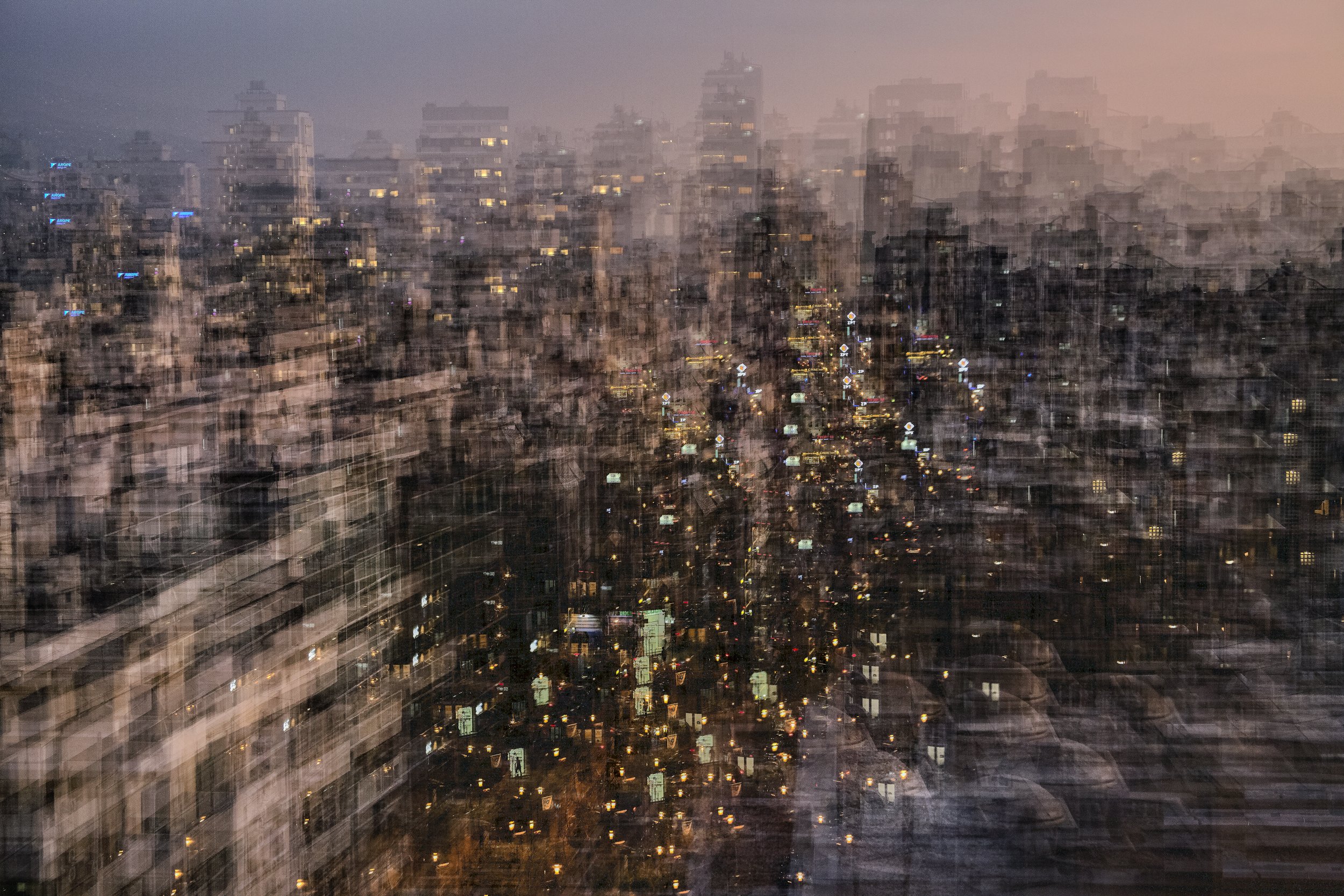
IMPRESSION 2, from the series Impressions, 2019. © Diana Mehrez

IMPRESSION 3, from the series Impressions, 2023. © Diana Mehrez
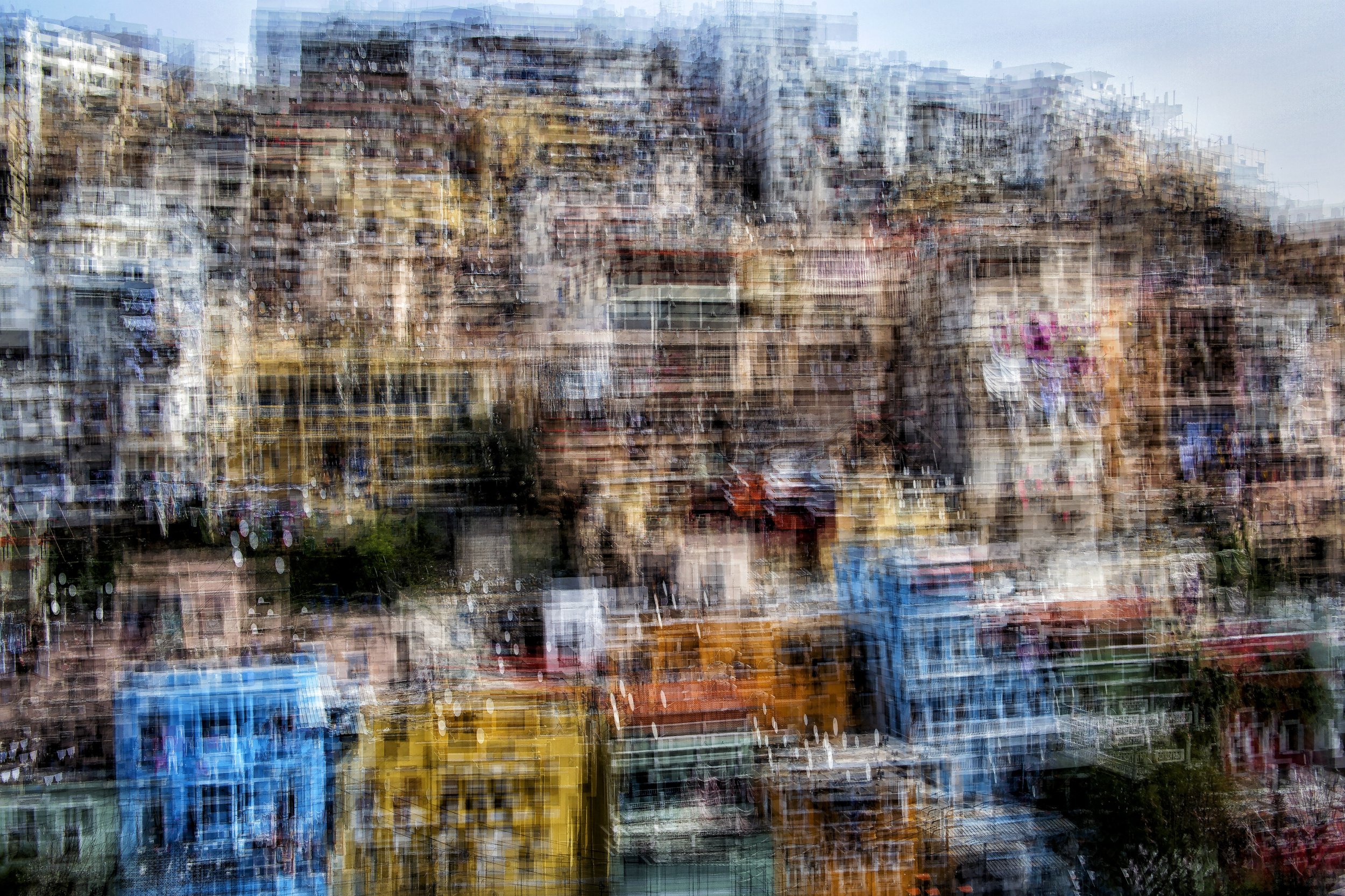
IMPRESSION T, from the series Impressions, 2019. © Diana Mehrez
Mehrez’s work has been widely recognized and exhibited. Notable showcases include the Beirut Art Fair and FotoNostrum Mediterranean House of Photography in Barcelona. She has also garnered accolades such as a finalist position in Architizer’s One Photo Challenge, multiple PX3 Paris Photo Awards, and Honorable Mentions from the International Photography Awards. Her talent has earned her representation by Jacques Ouaiss Gallery in Lebanon and collaborations with Gallery C6 in Barcelona.
UNTITLED 1, from the series Anatomy of Light, 2022. © Diana Mehrez
UNTITLED 2, from he series Anatomy of Light, 2022. © Diana Mehrez
UNTITLED 3, from he series Anatomy of Light, 2022. © Diana Mehrez
As a self-taught photographer, Mehrez embraces the unpredictability of her craft. She often revisits locations, experimenting with angles and light, until she captures a moment that fully reflects her emotions about the subject. “There’s a certain excitement in waiting for all the conditions to align—whether it’s the weather, light, or the right person passing through the frame. It’s a methodical yet intuitive process,” she explains.
FLOOR IS LAVA, from the series The Intrusions, 2019. © Diana Mehrez
Mehrez describes her creative journey as nonlinear, filled with experimentation, self-criticism, and growth. “The most fulfilling work comes when you stay true to your own interests and embrace the process. It’s through trial and error that you find your voice, and when you see your art out there in the world, you know it’s a reflection of yourself,” she says, a sentiment that encapsulates her approach to both life and art.
UNTITLED 4, from he series Anatomy of Light, 2022. © Diana Mehrez
DOT, from the series The Intrusions, 2012. © Diana Mehrez
“The most fulfilling work comes when you stay true to your own interests and embrace the process.”
Now at FotoNostrum
FotoNostrum has always been committed to recognizing and supporting female photographers, valuing their contributions to the field, showcasing their work in our exhibitions and through the Julia Margaret Cameron Awards, a competition exclusively for women, reinforcing our ongoing effort to promote and elevate their artistic voices. In line with this commitment, we are proud to present a solo exhibition of one of the most renowned female photographers—Lee Miller.
FotoNostrum Gallery proudly presents Lee Miller: Chronicles of War, an exhibition dedicated to the groundbreaking photojournalist who fearlessly documented some of the most defining moments of the 20th century. From the frontlines of World War II to the liberation of concentration camps, Miller’s lens captured history with raw intensity and unflinching honesty. A former fashion model turned war correspondent, her images transcend mere documentation, offering a deeply personal and humanistic perspective on war and its aftermath. This exhibition showcases a selection of her most powerful works, revealing both the brutality of conflict and the resilience of the human spirit. Lee Miller: Chronicles of War on view from January 17th to March 20th at FotoNostrum Mediterranean House of Photography.






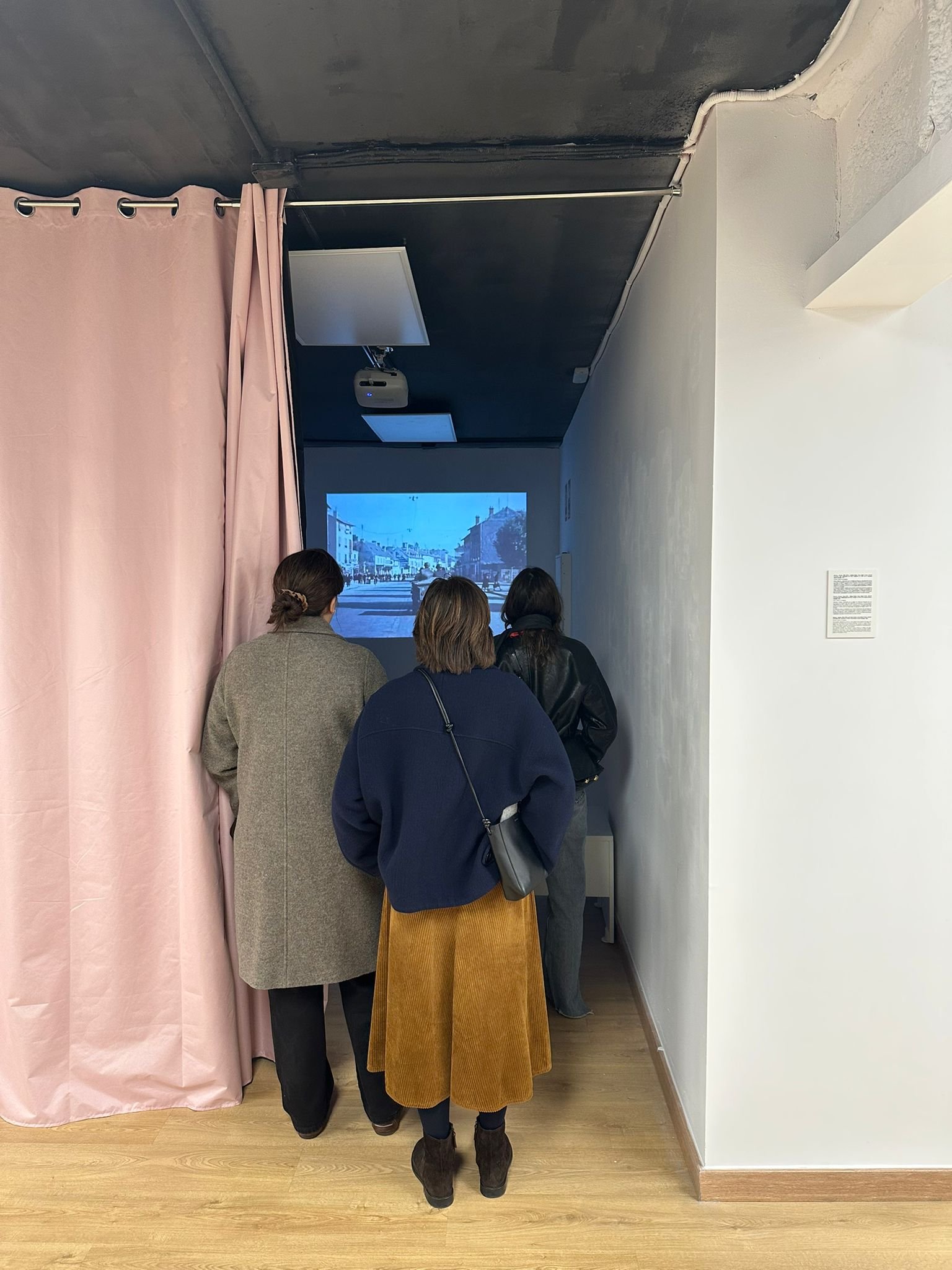


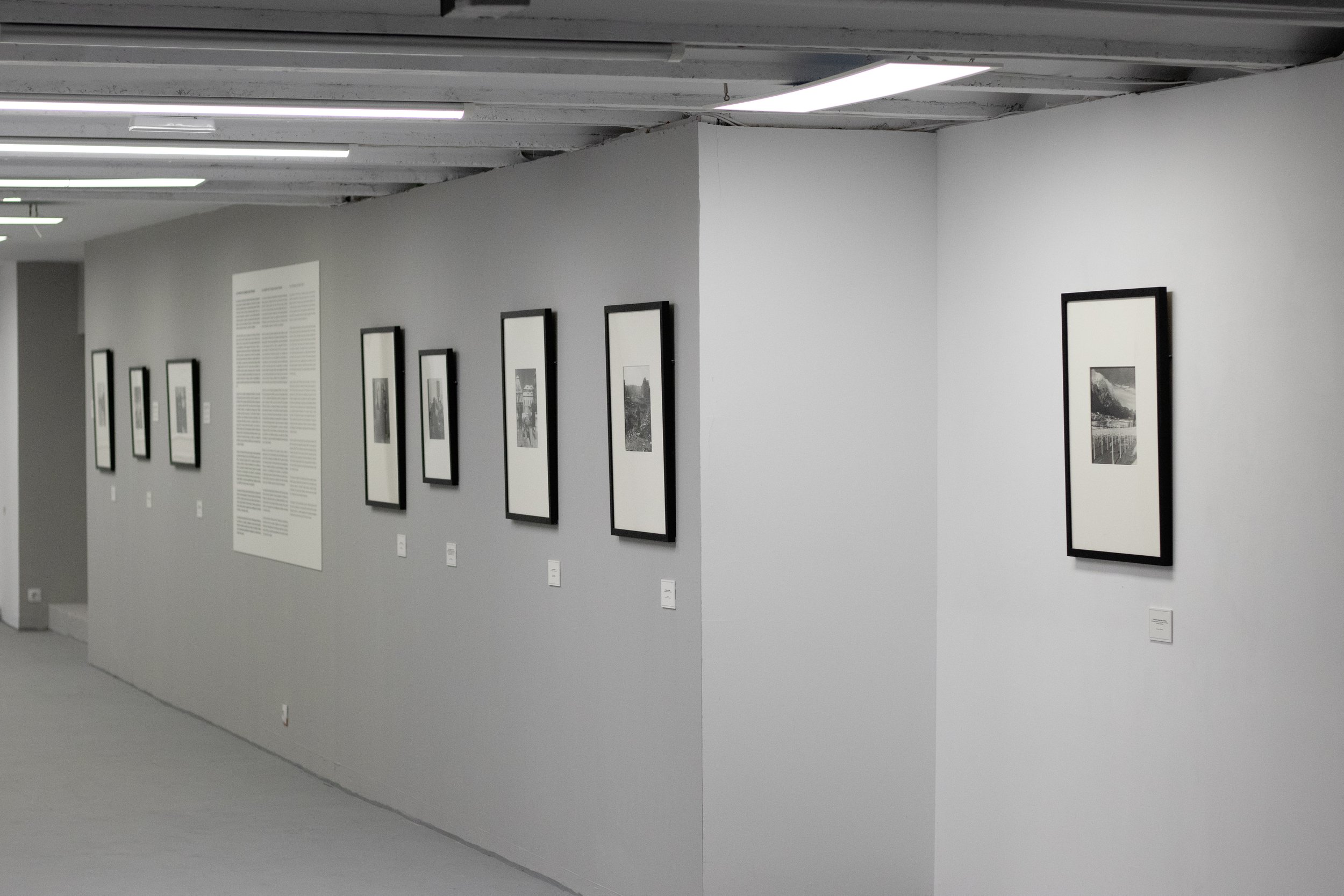
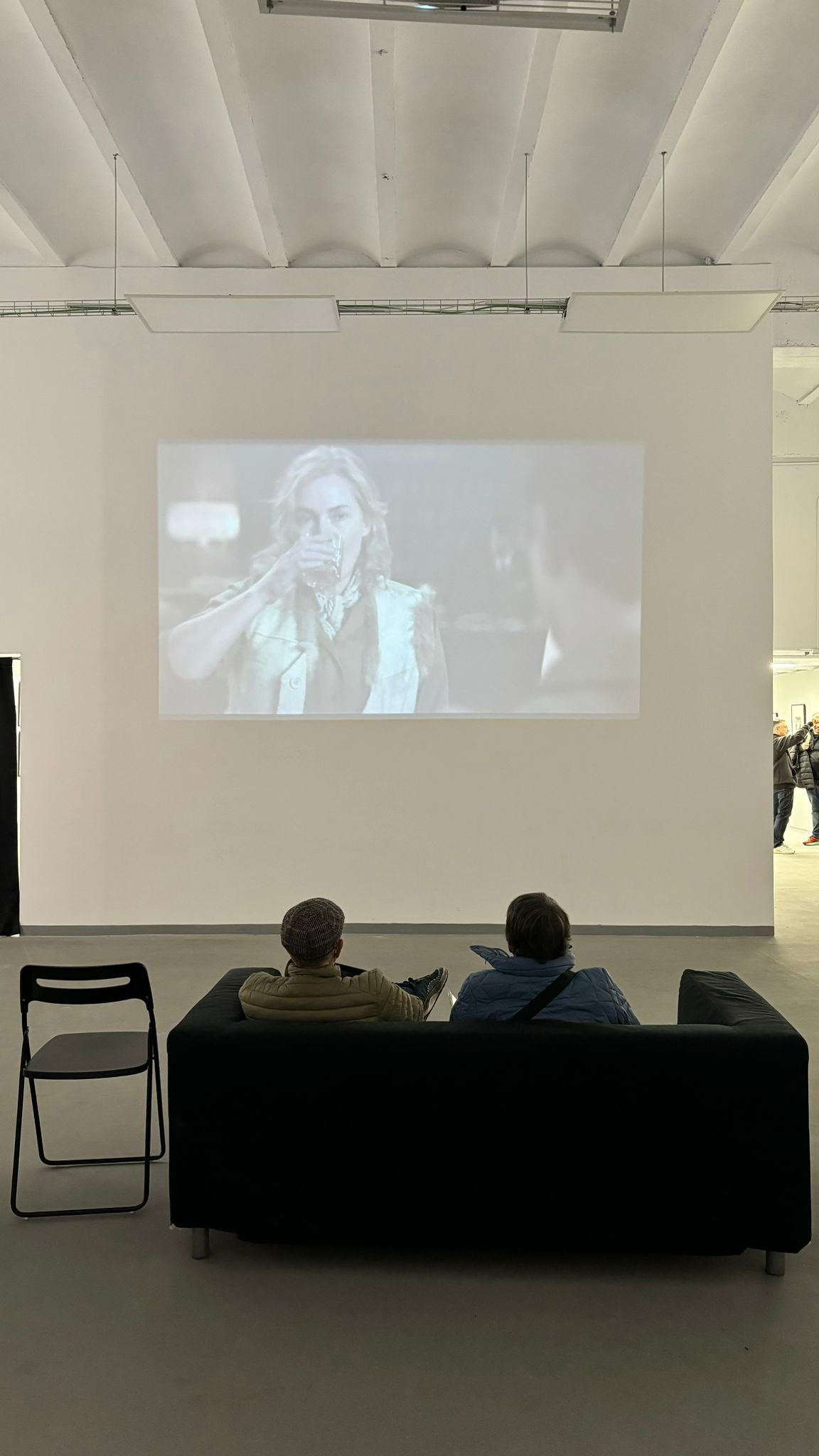


PUBLISHED PHOTOGRAPHERS
Patricia McElroy
Sushilla Kouwen
Dai Nakamura
Elisa Miller
Knesiia Antipina
Diana Mehrez
Cover: MAGGOT BRAIN © 2024, Sushilla Kouwen
Issue #42 March 20, 2025
Publisher Julio Hirsch-Hardy
Editor-at-large Analy Werbin
Coordinator Leonor Fernandes
Art Director Michal Meliško
Web Design Laura Vilanova
Graphic Designer Maria Krawczyk



































